Audit Report to Managing Partner, John Richards
VerifiedAdded on 2023/06/05
|24
|5147
|488
AI Summary
This report seeks to analyze and discuss various areas and accounts with regard to the audit of Trunkey Creek Wines (TCW) Limited. These are investments, accounts receivable, marketing expense and property assets. After analyzing the ratios and additional information, it has been noted that there are several business risks faced by Trunkey Creek Wines (TCW) Limited. These are strategic risk, compliance risk, operational risk, financial risk and technological risk.
Contribute Materials
Your contribution can guide someone’s learning journey. Share your
documents today.
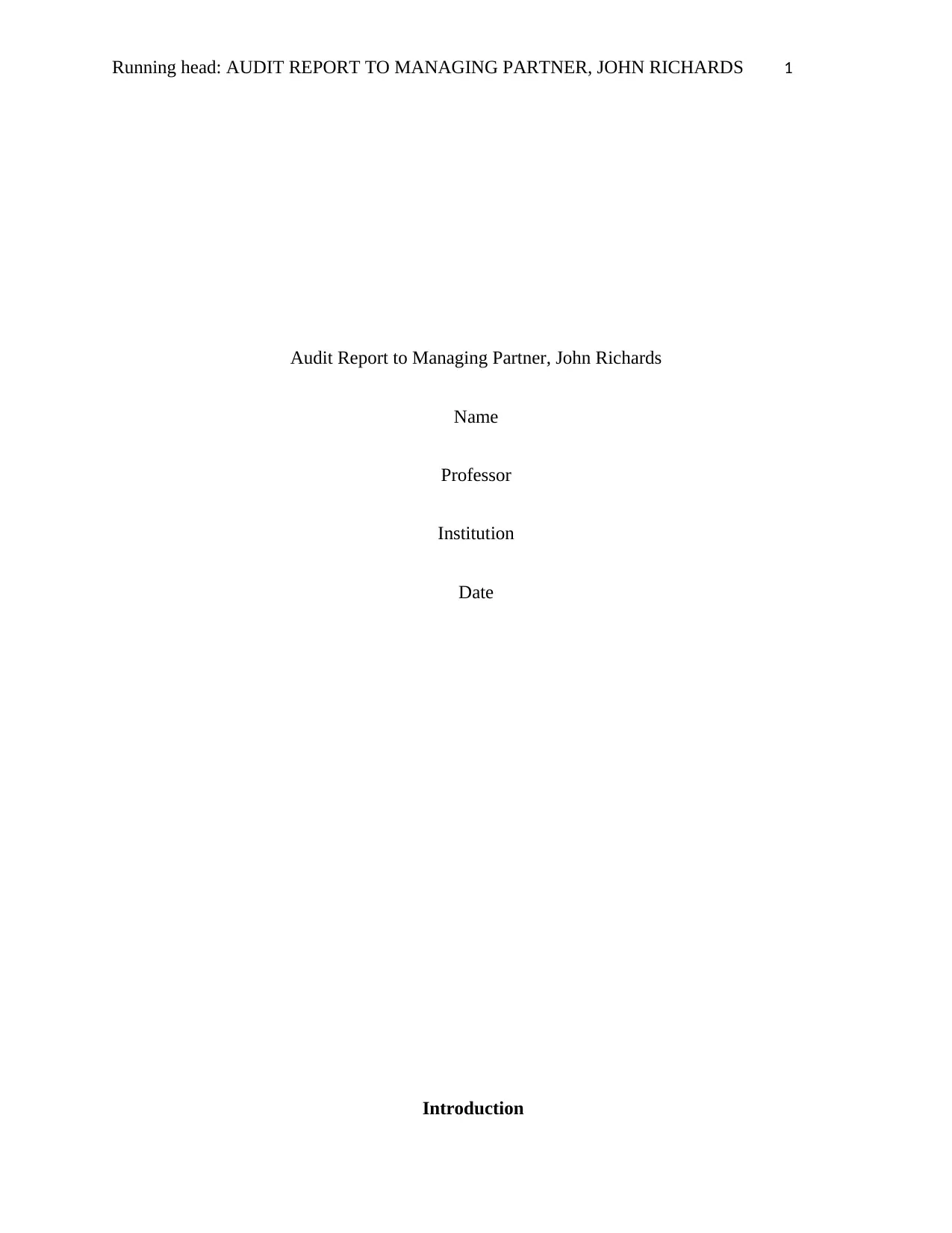
Running head: AUDIT REPORT TO MANAGING PARTNER, JOHN RICHARDS 1
Audit Report to Managing Partner, John Richards
Name
Professor
Institution
Date
Introduction
Audit Report to Managing Partner, John Richards
Name
Professor
Institution
Date
Introduction
Secure Best Marks with AI Grader
Need help grading? Try our AI Grader for instant feedback on your assignments.
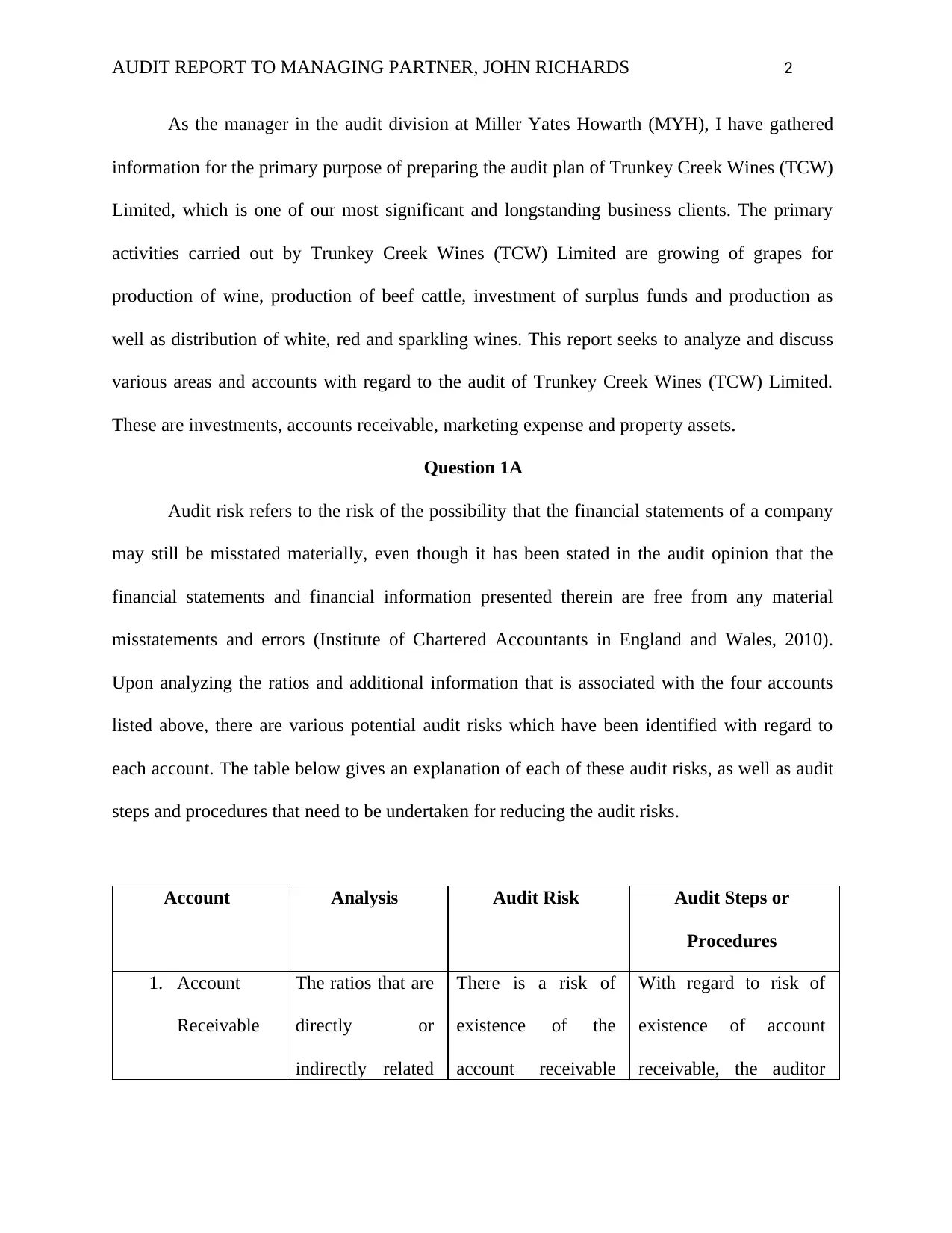
AUDIT REPORT TO MANAGING PARTNER, JOHN RICHARDS 2
As the manager in the audit division at Miller Yates Howarth (MYH), I have gathered
information for the primary purpose of preparing the audit plan of Trunkey Creek Wines (TCW)
Limited, which is one of our most significant and longstanding business clients. The primary
activities carried out by Trunkey Creek Wines (TCW) Limited are growing of grapes for
production of wine, production of beef cattle, investment of surplus funds and production as
well as distribution of white, red and sparkling wines. This report seeks to analyze and discuss
various areas and accounts with regard to the audit of Trunkey Creek Wines (TCW) Limited.
These are investments, accounts receivable, marketing expense and property assets.
Question 1A
Audit risk refers to the risk of the possibility that the financial statements of a company
may still be misstated materially, even though it has been stated in the audit opinion that the
financial statements and financial information presented therein are free from any material
misstatements and errors (Institute of Chartered Accountants in England and Wales, 2010).
Upon analyzing the ratios and additional information that is associated with the four accounts
listed above, there are various potential audit risks which have been identified with regard to
each account. The table below gives an explanation of each of these audit risks, as well as audit
steps and procedures that need to be undertaken for reducing the audit risks.
Account Analysis Audit Risk Audit Steps or
Procedures
1. Account
Receivable
The ratios that are
directly or
indirectly related
There is a risk of
existence of the
account receivable
With regard to risk of
existence of account
receivable, the auditor
As the manager in the audit division at Miller Yates Howarth (MYH), I have gathered
information for the primary purpose of preparing the audit plan of Trunkey Creek Wines (TCW)
Limited, which is one of our most significant and longstanding business clients. The primary
activities carried out by Trunkey Creek Wines (TCW) Limited are growing of grapes for
production of wine, production of beef cattle, investment of surplus funds and production as
well as distribution of white, red and sparkling wines. This report seeks to analyze and discuss
various areas and accounts with regard to the audit of Trunkey Creek Wines (TCW) Limited.
These are investments, accounts receivable, marketing expense and property assets.
Question 1A
Audit risk refers to the risk of the possibility that the financial statements of a company
may still be misstated materially, even though it has been stated in the audit opinion that the
financial statements and financial information presented therein are free from any material
misstatements and errors (Institute of Chartered Accountants in England and Wales, 2010).
Upon analyzing the ratios and additional information that is associated with the four accounts
listed above, there are various potential audit risks which have been identified with regard to
each account. The table below gives an explanation of each of these audit risks, as well as audit
steps and procedures that need to be undertaken for reducing the audit risks.
Account Analysis Audit Risk Audit Steps or
Procedures
1. Account
Receivable
The ratios that are
directly or
indirectly related
There is a risk of
existence of the
account receivable
With regard to risk of
existence of account
receivable, the auditor
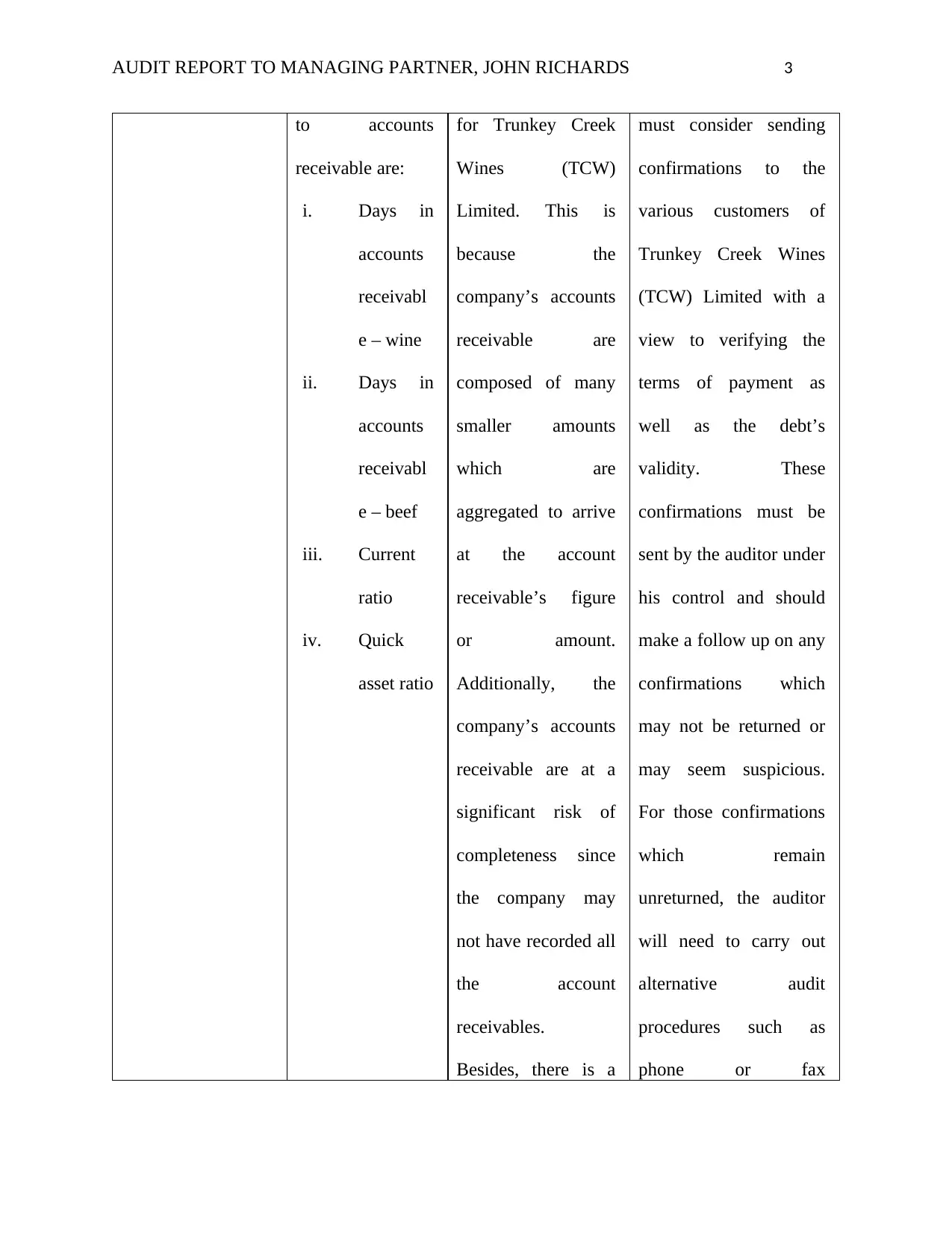
AUDIT REPORT TO MANAGING PARTNER, JOHN RICHARDS 3
to accounts
receivable are:
i. Days in
accounts
receivabl
e – wine
ii. Days in
accounts
receivabl
e – beef
iii. Current
ratio
iv. Quick
asset ratio
for Trunkey Creek
Wines (TCW)
Limited. This is
because the
company’s accounts
receivable are
composed of many
smaller amounts
which are
aggregated to arrive
at the account
receivable’s figure
or amount.
Additionally, the
company’s accounts
receivable are at a
significant risk of
completeness since
the company may
not have recorded all
the account
receivables.
Besides, there is a
must consider sending
confirmations to the
various customers of
Trunkey Creek Wines
(TCW) Limited with a
view to verifying the
terms of payment as
well as the debt’s
validity. These
confirmations must be
sent by the auditor under
his control and should
make a follow up on any
confirmations which
may not be returned or
may seem suspicious.
For those confirmations
which remain
unreturned, the auditor
will need to carry out
alternative audit
procedures such as
phone or fax
to accounts
receivable are:
i. Days in
accounts
receivabl
e – wine
ii. Days in
accounts
receivabl
e – beef
iii. Current
ratio
iv. Quick
asset ratio
for Trunkey Creek
Wines (TCW)
Limited. This is
because the
company’s accounts
receivable are
composed of many
smaller amounts
which are
aggregated to arrive
at the account
receivable’s figure
or amount.
Additionally, the
company’s accounts
receivable are at a
significant risk of
completeness since
the company may
not have recorded all
the account
receivables.
Besides, there is a
must consider sending
confirmations to the
various customers of
Trunkey Creek Wines
(TCW) Limited with a
view to verifying the
terms of payment as
well as the debt’s
validity. These
confirmations must be
sent by the auditor under
his control and should
make a follow up on any
confirmations which
may not be returned or
may seem suspicious.
For those confirmations
which remain
unreturned, the auditor
will need to carry out
alternative audit
procedures such as
phone or fax

AUDIT REPORT TO MANAGING PARTNER, JOHN RICHARDS 4
risk of valuation and
allocation of account
receivable. This is
because Trunkey
Creek Wines (TCW)
Limited should hold
the account
receivables as net
realizable value.
There is a potential
risk that the
company has not
properly estimated
the collectability of
the receivables and
may not have
reduced the balance
by an allowance for
doubtful accounts.
correspondence as well
as examining subsequent
cash receipts of the
company.
With regard to
completeness, the
auditor must look at
transactions of Trunkey
Creek Wines (TCW)
Limited around the cut
off dates of its operating
period, since he cannot
test the records of the
company for what is not
there. The risk of
completeness of
accounts receivables is
reduced by making an
assessment of the
company’s sales process
and confirming that the
company is able to
process transactions in
risk of valuation and
allocation of account
receivable. This is
because Trunkey
Creek Wines (TCW)
Limited should hold
the account
receivables as net
realizable value.
There is a potential
risk that the
company has not
properly estimated
the collectability of
the receivables and
may not have
reduced the balance
by an allowance for
doubtful accounts.
correspondence as well
as examining subsequent
cash receipts of the
company.
With regard to
completeness, the
auditor must look at
transactions of Trunkey
Creek Wines (TCW)
Limited around the cut
off dates of its operating
period, since he cannot
test the records of the
company for what is not
there. The risk of
completeness of
accounts receivables is
reduced by making an
assessment of the
company’s sales process
and confirming that the
company is able to
process transactions in
Paraphrase This Document
Need a fresh take? Get an instant paraphrase of this document with our AI Paraphraser
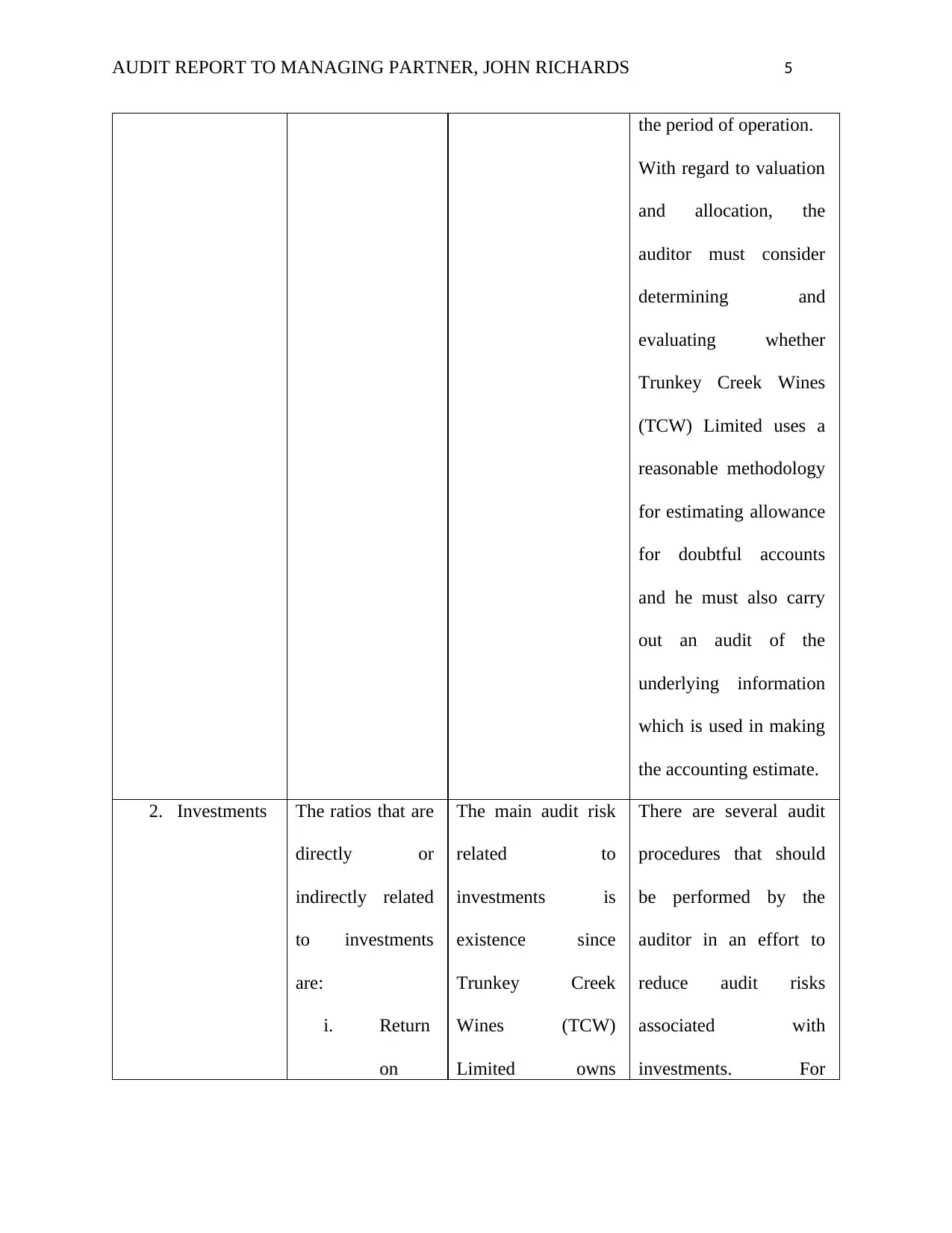
AUDIT REPORT TO MANAGING PARTNER, JOHN RICHARDS 5
the period of operation.
With regard to valuation
and allocation, the
auditor must consider
determining and
evaluating whether
Trunkey Creek Wines
(TCW) Limited uses a
reasonable methodology
for estimating allowance
for doubtful accounts
and he must also carry
out an audit of the
underlying information
which is used in making
the accounting estimate.
2. Investments The ratios that are
directly or
indirectly related
to investments
are:
i. Return
on
The main audit risk
related to
investments is
existence since
Trunkey Creek
Wines (TCW)
Limited owns
There are several audit
procedures that should
be performed by the
auditor in an effort to
reduce audit risks
associated with
investments. For
the period of operation.
With regard to valuation
and allocation, the
auditor must consider
determining and
evaluating whether
Trunkey Creek Wines
(TCW) Limited uses a
reasonable methodology
for estimating allowance
for doubtful accounts
and he must also carry
out an audit of the
underlying information
which is used in making
the accounting estimate.
2. Investments The ratios that are
directly or
indirectly related
to investments
are:
i. Return
on
The main audit risk
related to
investments is
existence since
Trunkey Creek
Wines (TCW)
Limited owns
There are several audit
procedures that should
be performed by the
auditor in an effort to
reduce audit risks
associated with
investments. For
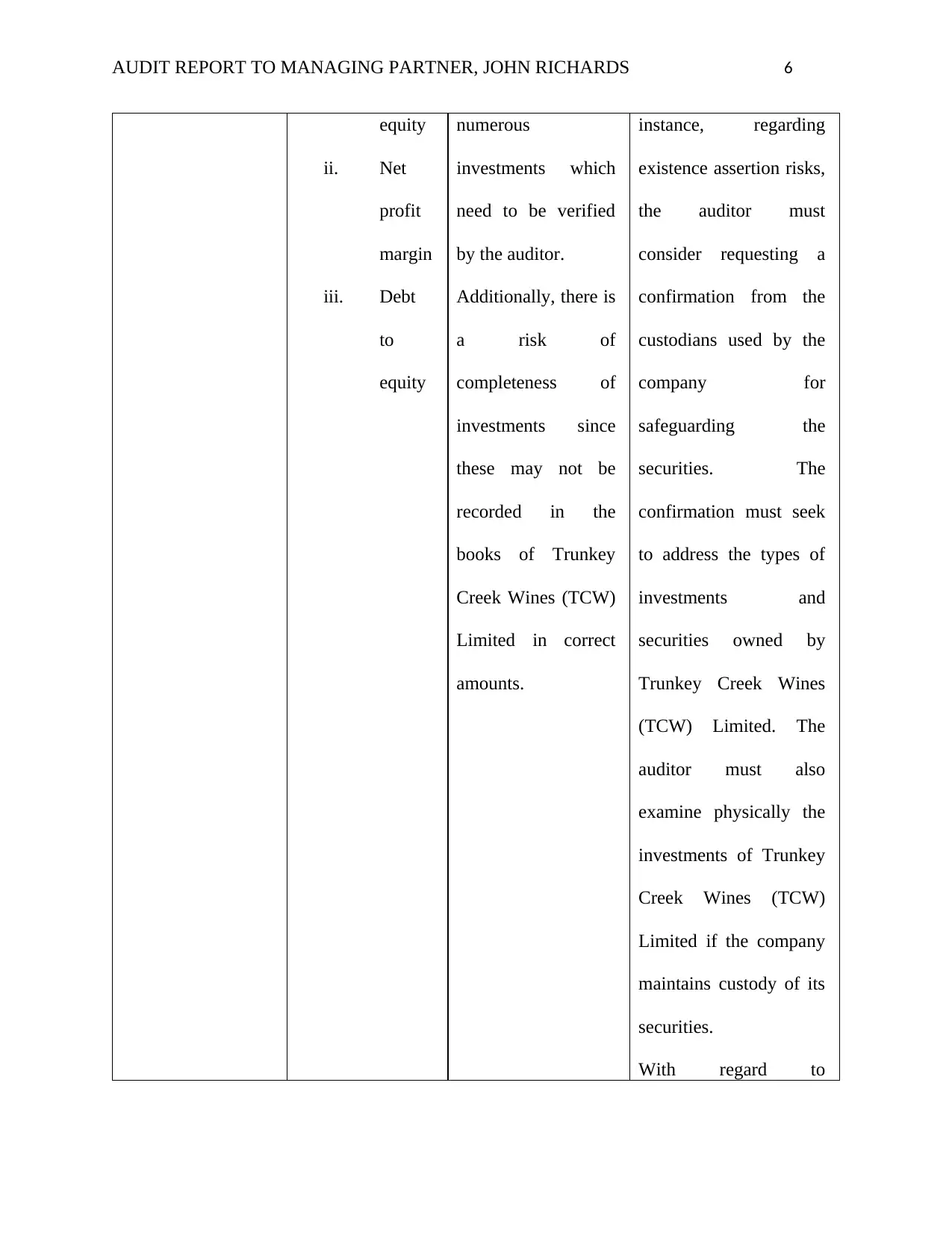
AUDIT REPORT TO MANAGING PARTNER, JOHN RICHARDS 6
equity
ii. Net
profit
margin
iii. Debt
to
equity
numerous
investments which
need to be verified
by the auditor.
Additionally, there is
a risk of
completeness of
investments since
these may not be
recorded in the
books of Trunkey
Creek Wines (TCW)
Limited in correct
amounts.
instance, regarding
existence assertion risks,
the auditor must
consider requesting a
confirmation from the
custodians used by the
company for
safeguarding the
securities. The
confirmation must seek
to address the types of
investments and
securities owned by
Trunkey Creek Wines
(TCW) Limited. The
auditor must also
examine physically the
investments of Trunkey
Creek Wines (TCW)
Limited if the company
maintains custody of its
securities.
With regard to
equity
ii. Net
profit
margin
iii. Debt
to
equity
numerous
investments which
need to be verified
by the auditor.
Additionally, there is
a risk of
completeness of
investments since
these may not be
recorded in the
books of Trunkey
Creek Wines (TCW)
Limited in correct
amounts.
instance, regarding
existence assertion risks,
the auditor must
consider requesting a
confirmation from the
custodians used by the
company for
safeguarding the
securities. The
confirmation must seek
to address the types of
investments and
securities owned by
Trunkey Creek Wines
(TCW) Limited. The
auditor must also
examine physically the
investments of Trunkey
Creek Wines (TCW)
Limited if the company
maintains custody of its
securities.
With regard to

AUDIT REPORT TO MANAGING PARTNER, JOHN RICHARDS 7
completeness, the
auditor must consider
confirming whether the
company has properly
recorded the amount of
its investments in its
financial records.
Furthermore, he must
ensure that dividend and
interest related to
investments is recorded
in the financial
statements of Trunkey
Creek Wines (TCW)
Limited as revenue.
3. Property
Assets
The ratios which
are directly or
indirectly related
to property assets
include:
i. Return
on
beef
Existence,
completeness and
valuation or
allocation are the
main audit risk
assertions that are
related to property
assets with regard to
With regard to risk of
existence of property
assets, the auditor must
consider physically
examining the various
production with a view
to ascertaining and
confirming that the
completeness, the
auditor must consider
confirming whether the
company has properly
recorded the amount of
its investments in its
financial records.
Furthermore, he must
ensure that dividend and
interest related to
investments is recorded
in the financial
statements of Trunkey
Creek Wines (TCW)
Limited as revenue.
3. Property
Assets
The ratios which
are directly or
indirectly related
to property assets
include:
i. Return
on
beef
Existence,
completeness and
valuation or
allocation are the
main audit risk
assertions that are
related to property
assets with regard to
With regard to risk of
existence of property
assets, the auditor must
consider physically
examining the various
production with a view
to ascertaining and
confirming that the
Secure Best Marks with AI Grader
Need help grading? Try our AI Grader for instant feedback on your assignments.
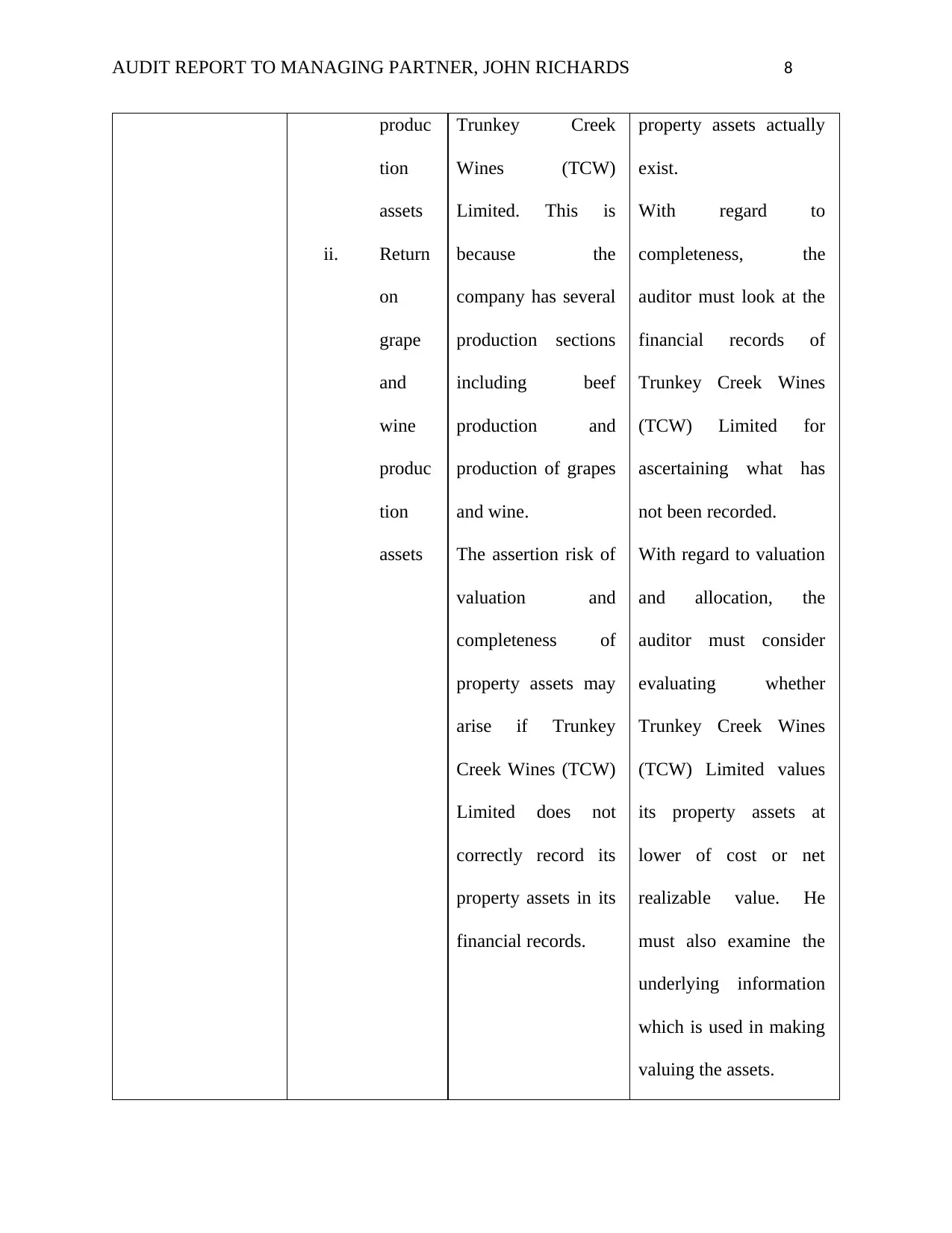
AUDIT REPORT TO MANAGING PARTNER, JOHN RICHARDS 8
produc
tion
assets
ii. Return
on
grape
and
wine
produc
tion
assets
Trunkey Creek
Wines (TCW)
Limited. This is
because the
company has several
production sections
including beef
production and
production of grapes
and wine.
The assertion risk of
valuation and
completeness of
property assets may
arise if Trunkey
Creek Wines (TCW)
Limited does not
correctly record its
property assets in its
financial records.
property assets actually
exist.
With regard to
completeness, the
auditor must look at the
financial records of
Trunkey Creek Wines
(TCW) Limited for
ascertaining what has
not been recorded.
With regard to valuation
and allocation, the
auditor must consider
evaluating whether
Trunkey Creek Wines
(TCW) Limited values
its property assets at
lower of cost or net
realizable value. He
must also examine the
underlying information
which is used in making
valuing the assets.
produc
tion
assets
ii. Return
on
grape
and
wine
produc
tion
assets
Trunkey Creek
Wines (TCW)
Limited. This is
because the
company has several
production sections
including beef
production and
production of grapes
and wine.
The assertion risk of
valuation and
completeness of
property assets may
arise if Trunkey
Creek Wines (TCW)
Limited does not
correctly record its
property assets in its
financial records.
property assets actually
exist.
With regard to
completeness, the
auditor must look at the
financial records of
Trunkey Creek Wines
(TCW) Limited for
ascertaining what has
not been recorded.
With regard to valuation
and allocation, the
auditor must consider
evaluating whether
Trunkey Creek Wines
(TCW) Limited values
its property assets at
lower of cost or net
realizable value. He
must also examine the
underlying information
which is used in making
valuing the assets.
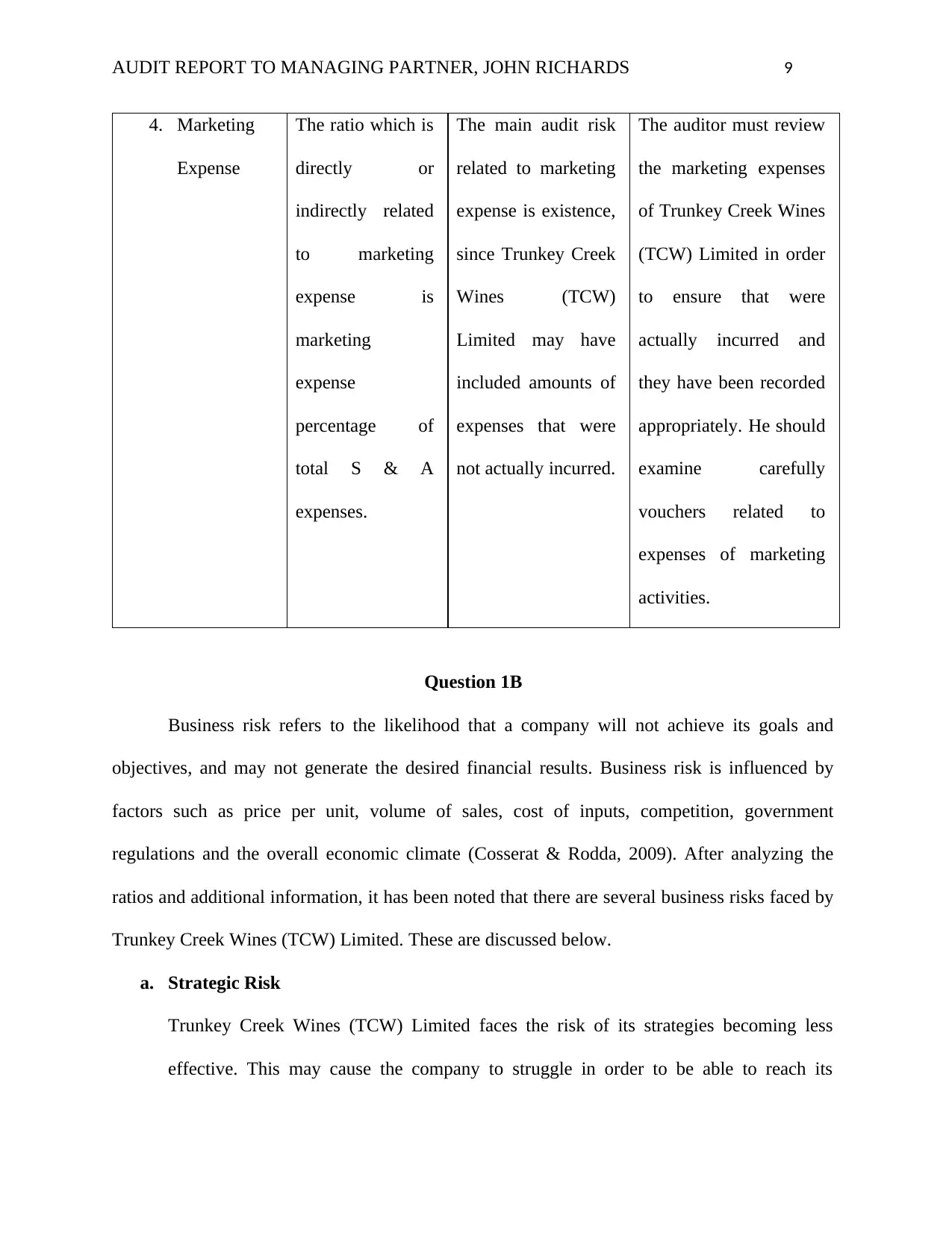
AUDIT REPORT TO MANAGING PARTNER, JOHN RICHARDS 9
4. Marketing
Expense
The ratio which is
directly or
indirectly related
to marketing
expense is
marketing
expense
percentage of
total S & A
expenses.
The main audit risk
related to marketing
expense is existence,
since Trunkey Creek
Wines (TCW)
Limited may have
included amounts of
expenses that were
not actually incurred.
The auditor must review
the marketing expenses
of Trunkey Creek Wines
(TCW) Limited in order
to ensure that were
actually incurred and
they have been recorded
appropriately. He should
examine carefully
vouchers related to
expenses of marketing
activities.
Question 1B
Business risk refers to the likelihood that a company will not achieve its goals and
objectives, and may not generate the desired financial results. Business risk is influenced by
factors such as price per unit, volume of sales, cost of inputs, competition, government
regulations and the overall economic climate (Cosserat & Rodda, 2009). After analyzing the
ratios and additional information, it has been noted that there are several business risks faced by
Trunkey Creek Wines (TCW) Limited. These are discussed below.
a. Strategic Risk
Trunkey Creek Wines (TCW) Limited faces the risk of its strategies becoming less
effective. This may cause the company to struggle in order to be able to reach its
4. Marketing
Expense
The ratio which is
directly or
indirectly related
to marketing
expense is
marketing
expense
percentage of
total S & A
expenses.
The main audit risk
related to marketing
expense is existence,
since Trunkey Creek
Wines (TCW)
Limited may have
included amounts of
expenses that were
not actually incurred.
The auditor must review
the marketing expenses
of Trunkey Creek Wines
(TCW) Limited in order
to ensure that were
actually incurred and
they have been recorded
appropriately. He should
examine carefully
vouchers related to
expenses of marketing
activities.
Question 1B
Business risk refers to the likelihood that a company will not achieve its goals and
objectives, and may not generate the desired financial results. Business risk is influenced by
factors such as price per unit, volume of sales, cost of inputs, competition, government
regulations and the overall economic climate (Cosserat & Rodda, 2009). After analyzing the
ratios and additional information, it has been noted that there are several business risks faced by
Trunkey Creek Wines (TCW) Limited. These are discussed below.
a. Strategic Risk
Trunkey Creek Wines (TCW) Limited faces the risk of its strategies becoming less
effective. This may cause the company to struggle in order to be able to reach its
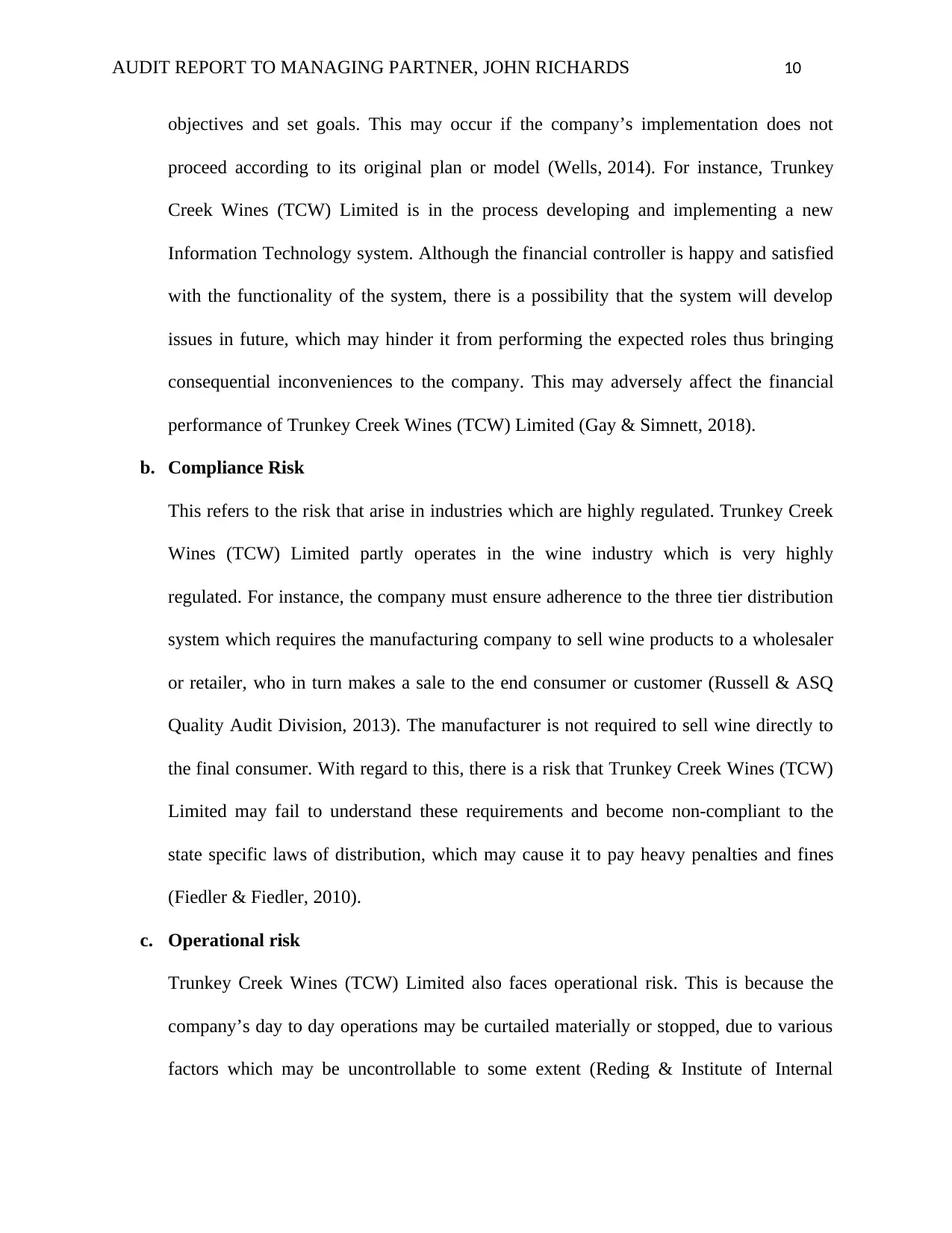
AUDIT REPORT TO MANAGING PARTNER, JOHN RICHARDS 10
objectives and set goals. This may occur if the company’s implementation does not
proceed according to its original plan or model (Wells, 2014). For instance, Trunkey
Creek Wines (TCW) Limited is in the process developing and implementing a new
Information Technology system. Although the financial controller is happy and satisfied
with the functionality of the system, there is a possibility that the system will develop
issues in future, which may hinder it from performing the expected roles thus bringing
consequential inconveniences to the company. This may adversely affect the financial
performance of Trunkey Creek Wines (TCW) Limited (Gay & Simnett, 2018).
b. Compliance Risk
This refers to the risk that arise in industries which are highly regulated. Trunkey Creek
Wines (TCW) Limited partly operates in the wine industry which is very highly
regulated. For instance, the company must ensure adherence to the three tier distribution
system which requires the manufacturing company to sell wine products to a wholesaler
or retailer, who in turn makes a sale to the end consumer or customer (Russell & ASQ
Quality Audit Division, 2013). The manufacturer is not required to sell wine directly to
the final consumer. With regard to this, there is a risk that Trunkey Creek Wines (TCW)
Limited may fail to understand these requirements and become non-compliant to the
state specific laws of distribution, which may cause it to pay heavy penalties and fines
(Fiedler & Fiedler, 2010).
c. Operational risk
Trunkey Creek Wines (TCW) Limited also faces operational risk. This is because the
company’s day to day operations may be curtailed materially or stopped, due to various
factors which may be uncontrollable to some extent (Reding & Institute of Internal
objectives and set goals. This may occur if the company’s implementation does not
proceed according to its original plan or model (Wells, 2014). For instance, Trunkey
Creek Wines (TCW) Limited is in the process developing and implementing a new
Information Technology system. Although the financial controller is happy and satisfied
with the functionality of the system, there is a possibility that the system will develop
issues in future, which may hinder it from performing the expected roles thus bringing
consequential inconveniences to the company. This may adversely affect the financial
performance of Trunkey Creek Wines (TCW) Limited (Gay & Simnett, 2018).
b. Compliance Risk
This refers to the risk that arise in industries which are highly regulated. Trunkey Creek
Wines (TCW) Limited partly operates in the wine industry which is very highly
regulated. For instance, the company must ensure adherence to the three tier distribution
system which requires the manufacturing company to sell wine products to a wholesaler
or retailer, who in turn makes a sale to the end consumer or customer (Russell & ASQ
Quality Audit Division, 2013). The manufacturer is not required to sell wine directly to
the final consumer. With regard to this, there is a risk that Trunkey Creek Wines (TCW)
Limited may fail to understand these requirements and become non-compliant to the
state specific laws of distribution, which may cause it to pay heavy penalties and fines
(Fiedler & Fiedler, 2010).
c. Operational risk
Trunkey Creek Wines (TCW) Limited also faces operational risk. This is because the
company’s day to day operations may be curtailed materially or stopped, due to various
factors which may be uncontrollable to some extent (Reding & Institute of Internal
Paraphrase This Document
Need a fresh take? Get an instant paraphrase of this document with our AI Paraphraser
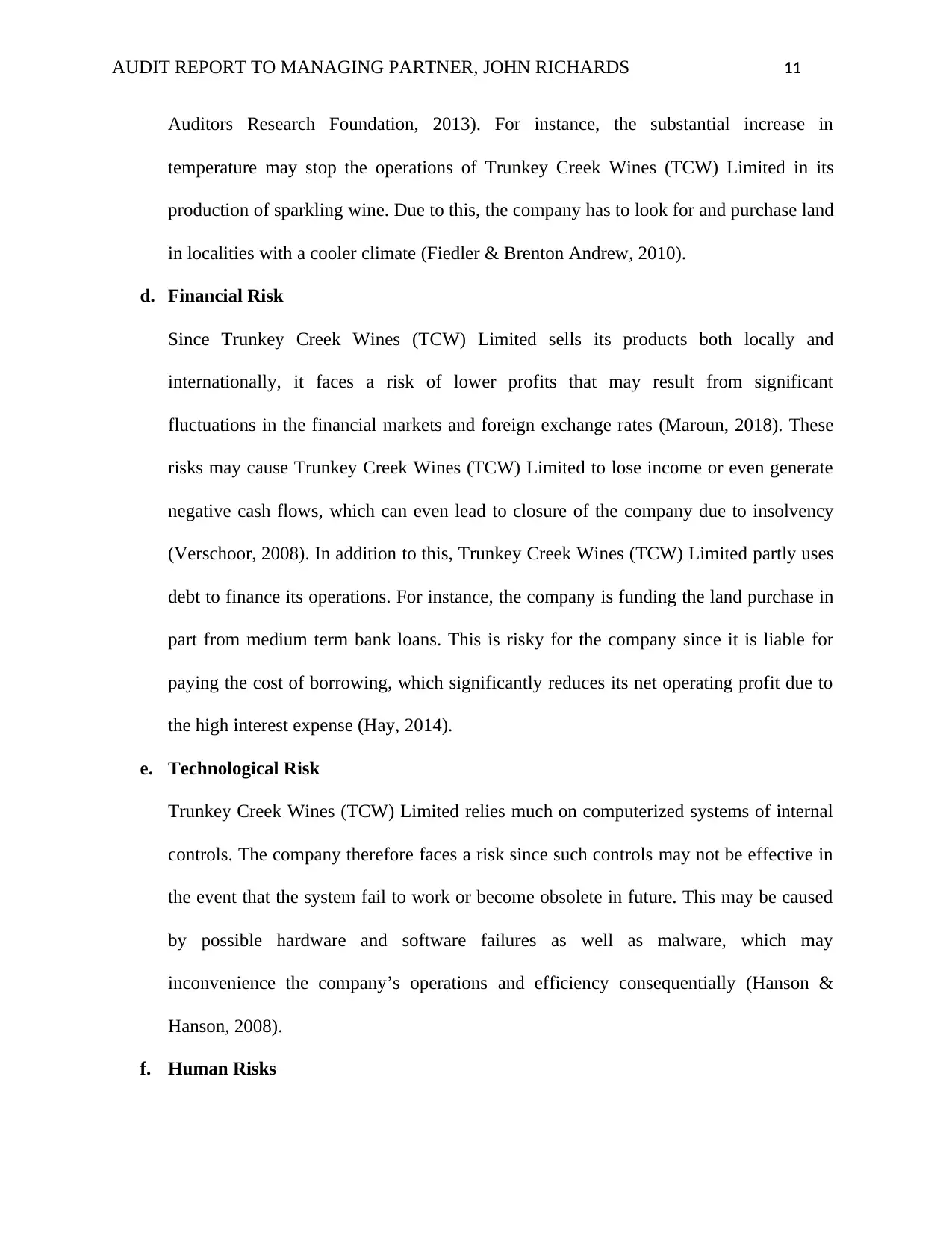
AUDIT REPORT TO MANAGING PARTNER, JOHN RICHARDS 11
Auditors Research Foundation, 2013). For instance, the substantial increase in
temperature may stop the operations of Trunkey Creek Wines (TCW) Limited in its
production of sparkling wine. Due to this, the company has to look for and purchase land
in localities with a cooler climate (Fiedler & Brenton Andrew, 2010).
d. Financial Risk
Since Trunkey Creek Wines (TCW) Limited sells its products both locally and
internationally, it faces a risk of lower profits that may result from significant
fluctuations in the financial markets and foreign exchange rates (Maroun, 2018). These
risks may cause Trunkey Creek Wines (TCW) Limited to lose income or even generate
negative cash flows, which can even lead to closure of the company due to insolvency
(Verschoor, 2008). In addition to this, Trunkey Creek Wines (TCW) Limited partly uses
debt to finance its operations. For instance, the company is funding the land purchase in
part from medium term bank loans. This is risky for the company since it is liable for
paying the cost of borrowing, which significantly reduces its net operating profit due to
the high interest expense (Hay, 2014).
e. Technological Risk
Trunkey Creek Wines (TCW) Limited relies much on computerized systems of internal
controls. The company therefore faces a risk since such controls may not be effective in
the event that the system fail to work or become obsolete in future. This may be caused
by possible hardware and software failures as well as malware, which may
inconvenience the company’s operations and efficiency consequentially (Hanson &
Hanson, 2008).
f. Human Risks
Auditors Research Foundation, 2013). For instance, the substantial increase in
temperature may stop the operations of Trunkey Creek Wines (TCW) Limited in its
production of sparkling wine. Due to this, the company has to look for and purchase land
in localities with a cooler climate (Fiedler & Brenton Andrew, 2010).
d. Financial Risk
Since Trunkey Creek Wines (TCW) Limited sells its products both locally and
internationally, it faces a risk of lower profits that may result from significant
fluctuations in the financial markets and foreign exchange rates (Maroun, 2018). These
risks may cause Trunkey Creek Wines (TCW) Limited to lose income or even generate
negative cash flows, which can even lead to closure of the company due to insolvency
(Verschoor, 2008). In addition to this, Trunkey Creek Wines (TCW) Limited partly uses
debt to finance its operations. For instance, the company is funding the land purchase in
part from medium term bank loans. This is risky for the company since it is liable for
paying the cost of borrowing, which significantly reduces its net operating profit due to
the high interest expense (Hay, 2014).
e. Technological Risk
Trunkey Creek Wines (TCW) Limited relies much on computerized systems of internal
controls. The company therefore faces a risk since such controls may not be effective in
the event that the system fail to work or become obsolete in future. This may be caused
by possible hardware and software failures as well as malware, which may
inconvenience the company’s operations and efficiency consequentially (Hanson &
Hanson, 2008).
f. Human Risks
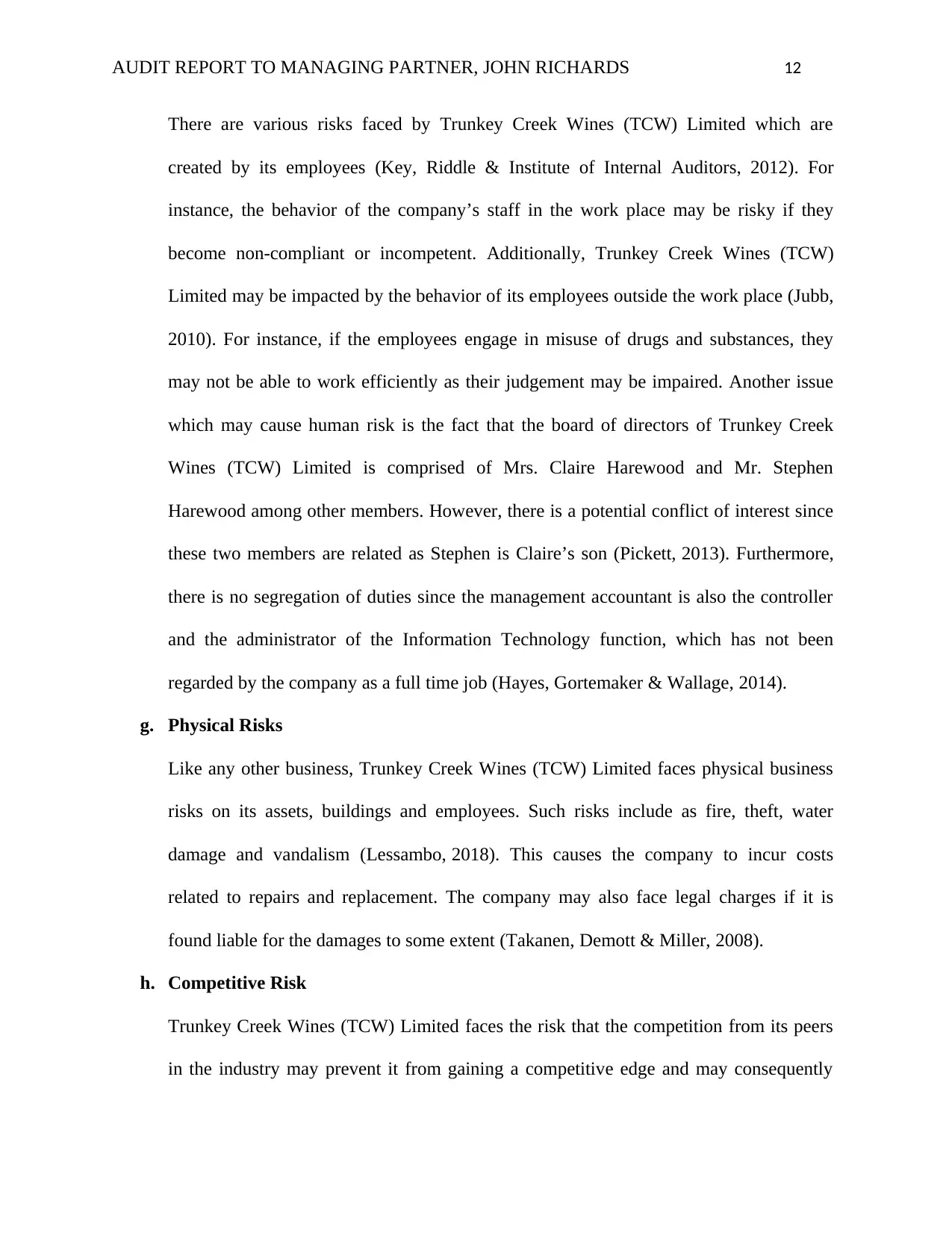
AUDIT REPORT TO MANAGING PARTNER, JOHN RICHARDS 12
There are various risks faced by Trunkey Creek Wines (TCW) Limited which are
created by its employees (Key, Riddle & Institute of Internal Auditors, 2012). For
instance, the behavior of the company’s staff in the work place may be risky if they
become non-compliant or incompetent. Additionally, Trunkey Creek Wines (TCW)
Limited may be impacted by the behavior of its employees outside the work place (Jubb,
2010). For instance, if the employees engage in misuse of drugs and substances, they
may not be able to work efficiently as their judgement may be impaired. Another issue
which may cause human risk is the fact that the board of directors of Trunkey Creek
Wines (TCW) Limited is comprised of Mrs. Claire Harewood and Mr. Stephen
Harewood among other members. However, there is a potential conflict of interest since
these two members are related as Stephen is Claire’s son (Pickett, 2013). Furthermore,
there is no segregation of duties since the management accountant is also the controller
and the administrator of the Information Technology function, which has not been
regarded by the company as a full time job (Hayes, Gortemaker & Wallage, 2014).
g. Physical Risks
Like any other business, Trunkey Creek Wines (TCW) Limited faces physical business
risks on its assets, buildings and employees. Such risks include as fire, theft, water
damage and vandalism (Lessambo, 2018). This causes the company to incur costs
related to repairs and replacement. The company may also face legal charges if it is
found liable for the damages to some extent (Takanen, Demott & Miller, 2008).
h. Competitive Risk
Trunkey Creek Wines (TCW) Limited faces the risk that the competition from its peers
in the industry may prevent it from gaining a competitive edge and may consequently
There are various risks faced by Trunkey Creek Wines (TCW) Limited which are
created by its employees (Key, Riddle & Institute of Internal Auditors, 2012). For
instance, the behavior of the company’s staff in the work place may be risky if they
become non-compliant or incompetent. Additionally, Trunkey Creek Wines (TCW)
Limited may be impacted by the behavior of its employees outside the work place (Jubb,
2010). For instance, if the employees engage in misuse of drugs and substances, they
may not be able to work efficiently as their judgement may be impaired. Another issue
which may cause human risk is the fact that the board of directors of Trunkey Creek
Wines (TCW) Limited is comprised of Mrs. Claire Harewood and Mr. Stephen
Harewood among other members. However, there is a potential conflict of interest since
these two members are related as Stephen is Claire’s son (Pickett, 2013). Furthermore,
there is no segregation of duties since the management accountant is also the controller
and the administrator of the Information Technology function, which has not been
regarded by the company as a full time job (Hayes, Gortemaker & Wallage, 2014).
g. Physical Risks
Like any other business, Trunkey Creek Wines (TCW) Limited faces physical business
risks on its assets, buildings and employees. Such risks include as fire, theft, water
damage and vandalism (Lessambo, 2018). This causes the company to incur costs
related to repairs and replacement. The company may also face legal charges if it is
found liable for the damages to some extent (Takanen, Demott & Miller, 2008).
h. Competitive Risk
Trunkey Creek Wines (TCW) Limited faces the risk that the competition from its peers
in the industry may prevent it from gaining a competitive edge and may consequently
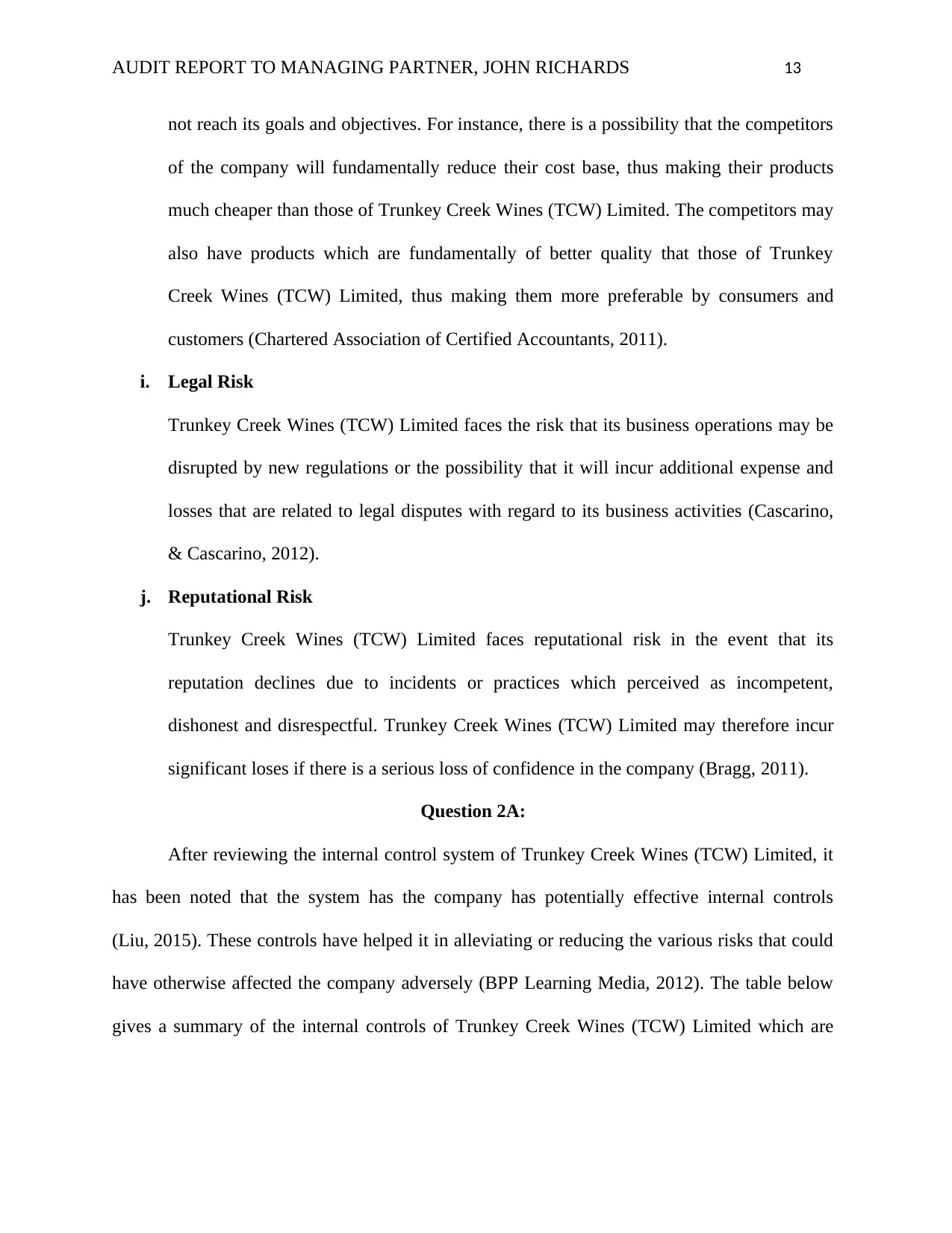
AUDIT REPORT TO MANAGING PARTNER, JOHN RICHARDS 13
not reach its goals and objectives. For instance, there is a possibility that the competitors
of the company will fundamentally reduce their cost base, thus making their products
much cheaper than those of Trunkey Creek Wines (TCW) Limited. The competitors may
also have products which are fundamentally of better quality that those of Trunkey
Creek Wines (TCW) Limited, thus making them more preferable by consumers and
customers (Chartered Association of Certified Accountants, 2011).
i. Legal Risk
Trunkey Creek Wines (TCW) Limited faces the risk that its business operations may be
disrupted by new regulations or the possibility that it will incur additional expense and
losses that are related to legal disputes with regard to its business activities (Cascarino,
& Cascarino, 2012).
j. Reputational Risk
Trunkey Creek Wines (TCW) Limited faces reputational risk in the event that its
reputation declines due to incidents or practices which perceived as incompetent,
dishonest and disrespectful. Trunkey Creek Wines (TCW) Limited may therefore incur
significant loses if there is a serious loss of confidence in the company (Bragg, 2011).
Question 2A:
After reviewing the internal control system of Trunkey Creek Wines (TCW) Limited, it
has been noted that the system has the company has potentially effective internal controls
(Liu, 2015). These controls have helped it in alleviating or reducing the various risks that could
have otherwise affected the company adversely (BPP Learning Media, 2012). The table below
gives a summary of the internal controls of Trunkey Creek Wines (TCW) Limited which are
not reach its goals and objectives. For instance, there is a possibility that the competitors
of the company will fundamentally reduce their cost base, thus making their products
much cheaper than those of Trunkey Creek Wines (TCW) Limited. The competitors may
also have products which are fundamentally of better quality that those of Trunkey
Creek Wines (TCW) Limited, thus making them more preferable by consumers and
customers (Chartered Association of Certified Accountants, 2011).
i. Legal Risk
Trunkey Creek Wines (TCW) Limited faces the risk that its business operations may be
disrupted by new regulations or the possibility that it will incur additional expense and
losses that are related to legal disputes with regard to its business activities (Cascarino,
& Cascarino, 2012).
j. Reputational Risk
Trunkey Creek Wines (TCW) Limited faces reputational risk in the event that its
reputation declines due to incidents or practices which perceived as incompetent,
dishonest and disrespectful. Trunkey Creek Wines (TCW) Limited may therefore incur
significant loses if there is a serious loss of confidence in the company (Bragg, 2011).
Question 2A:
After reviewing the internal control system of Trunkey Creek Wines (TCW) Limited, it
has been noted that the system has the company has potentially effective internal controls
(Liu, 2015). These controls have helped it in alleviating or reducing the various risks that could
have otherwise affected the company adversely (BPP Learning Media, 2012). The table below
gives a summary of the internal controls of Trunkey Creek Wines (TCW) Limited which are
Secure Best Marks with AI Grader
Need help grading? Try our AI Grader for instant feedback on your assignments.
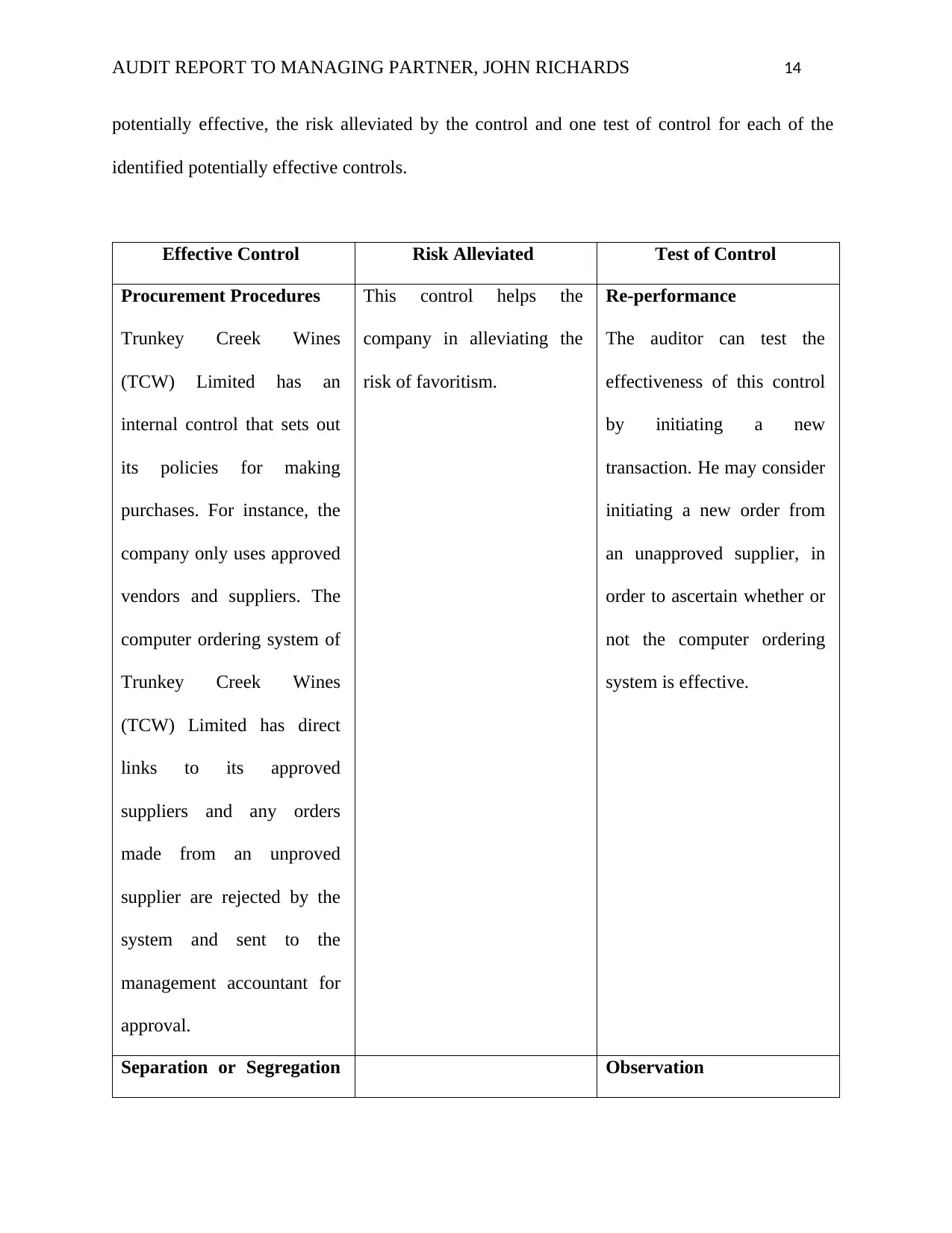
AUDIT REPORT TO MANAGING PARTNER, JOHN RICHARDS 14
potentially effective, the risk alleviated by the control and one test of control for each of the
identified potentially effective controls.
Effective Control Risk Alleviated Test of Control
Procurement Procedures
Trunkey Creek Wines
(TCW) Limited has an
internal control that sets out
its policies for making
purchases. For instance, the
company only uses approved
vendors and suppliers. The
computer ordering system of
Trunkey Creek Wines
(TCW) Limited has direct
links to its approved
suppliers and any orders
made from an unproved
supplier are rejected by the
system and sent to the
management accountant for
approval.
This control helps the
company in alleviating the
risk of favoritism.
Re-performance
The auditor can test the
effectiveness of this control
by initiating a new
transaction. He may consider
initiating a new order from
an unapproved supplier, in
order to ascertain whether or
not the computer ordering
system is effective.
Separation or Segregation Observation
potentially effective, the risk alleviated by the control and one test of control for each of the
identified potentially effective controls.
Effective Control Risk Alleviated Test of Control
Procurement Procedures
Trunkey Creek Wines
(TCW) Limited has an
internal control that sets out
its policies for making
purchases. For instance, the
company only uses approved
vendors and suppliers. The
computer ordering system of
Trunkey Creek Wines
(TCW) Limited has direct
links to its approved
suppliers and any orders
made from an unproved
supplier are rejected by the
system and sent to the
management accountant for
approval.
This control helps the
company in alleviating the
risk of favoritism.
Re-performance
The auditor can test the
effectiveness of this control
by initiating a new
transaction. He may consider
initiating a new order from
an unapproved supplier, in
order to ascertain whether or
not the computer ordering
system is effective.
Separation or Segregation Observation

AUDIT REPORT TO MANAGING PARTNER, JOHN RICHARDS 15
of Duties
Trunkey Creek Wines
(TCW) Limited has
segregated the duties and
responsibilities related to
book-keeping, cash
management, ordering,
reporting and auditing. For
instance, the management
accountant, the store men,
the accounts clerk, the
section mangers and the
company CEO play duties
which have been segregated.
This control alleviates the
potential risk of errors, fraud
or theft.
The auditor can use
observation as a test for this
control. For instance, he may
consider making an
observation of the various
roles played by the various
staff in the company such as
the company CEO, the
management accountant, the
store men, the accounts clerk
and the section managers.
Access Controls
The management of Trunkey
Creek Wines (TCW) Limited
has set access controls for
the various parts of its
accounting system through
use of passcodes, electronic
access logs and lock outs in
order to keep away
The risk alleviated by this
control is fraud.
Inspection
The auditor can test the
effectiveness of this control
through inspection. He can
do this by examining the
business documents of
Trunkey Creek Wines
(TCW) Limited in order to
ascertain that there is no
of Duties
Trunkey Creek Wines
(TCW) Limited has
segregated the duties and
responsibilities related to
book-keeping, cash
management, ordering,
reporting and auditing. For
instance, the management
accountant, the store men,
the accounts clerk, the
section mangers and the
company CEO play duties
which have been segregated.
This control alleviates the
potential risk of errors, fraud
or theft.
The auditor can use
observation as a test for this
control. For instance, he may
consider making an
observation of the various
roles played by the various
staff in the company such as
the company CEO, the
management accountant, the
store men, the accounts clerk
and the section managers.
Access Controls
The management of Trunkey
Creek Wines (TCW) Limited
has set access controls for
the various parts of its
accounting system through
use of passcodes, electronic
access logs and lock outs in
order to keep away
The risk alleviated by this
control is fraud.
Inspection
The auditor can test the
effectiveness of this control
through inspection. He can
do this by examining the
business documents of
Trunkey Creek Wines
(TCW) Limited in order to
ascertain that there is no
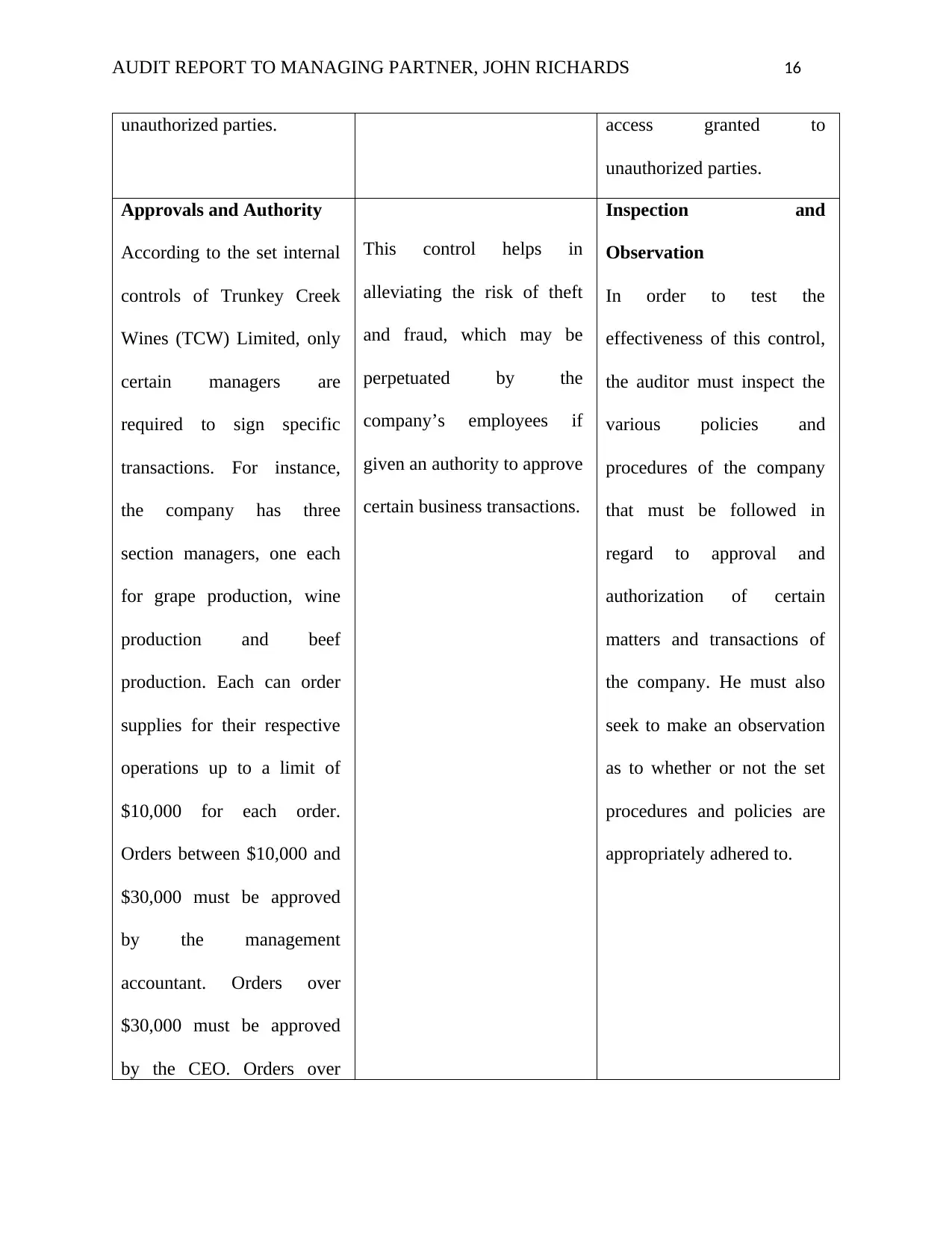
AUDIT REPORT TO MANAGING PARTNER, JOHN RICHARDS 16
unauthorized parties. access granted to
unauthorized parties.
Approvals and Authority
According to the set internal
controls of Trunkey Creek
Wines (TCW) Limited, only
certain managers are
required to sign specific
transactions. For instance,
the company has three
section managers, one each
for grape production, wine
production and beef
production. Each can order
supplies for their respective
operations up to a limit of
$10,000 for each order.
Orders between $10,000 and
$30,000 must be approved
by the management
accountant. Orders over
$30,000 must be approved
by the CEO. Orders over
This control helps in
alleviating the risk of theft
and fraud, which may be
perpetuated by the
company’s employees if
given an authority to approve
certain business transactions.
Inspection and
Observation
In order to test the
effectiveness of this control,
the auditor must inspect the
various policies and
procedures of the company
that must be followed in
regard to approval and
authorization of certain
matters and transactions of
the company. He must also
seek to make an observation
as to whether or not the set
procedures and policies are
appropriately adhered to.
unauthorized parties. access granted to
unauthorized parties.
Approvals and Authority
According to the set internal
controls of Trunkey Creek
Wines (TCW) Limited, only
certain managers are
required to sign specific
transactions. For instance,
the company has three
section managers, one each
for grape production, wine
production and beef
production. Each can order
supplies for their respective
operations up to a limit of
$10,000 for each order.
Orders between $10,000 and
$30,000 must be approved
by the management
accountant. Orders over
$30,000 must be approved
by the CEO. Orders over
This control helps in
alleviating the risk of theft
and fraud, which may be
perpetuated by the
company’s employees if
given an authority to approve
certain business transactions.
Inspection and
Observation
In order to test the
effectiveness of this control,
the auditor must inspect the
various policies and
procedures of the company
that must be followed in
regard to approval and
authorization of certain
matters and transactions of
the company. He must also
seek to make an observation
as to whether or not the set
procedures and policies are
appropriately adhered to.
Paraphrase This Document
Need a fresh take? Get an instant paraphrase of this document with our AI Paraphraser
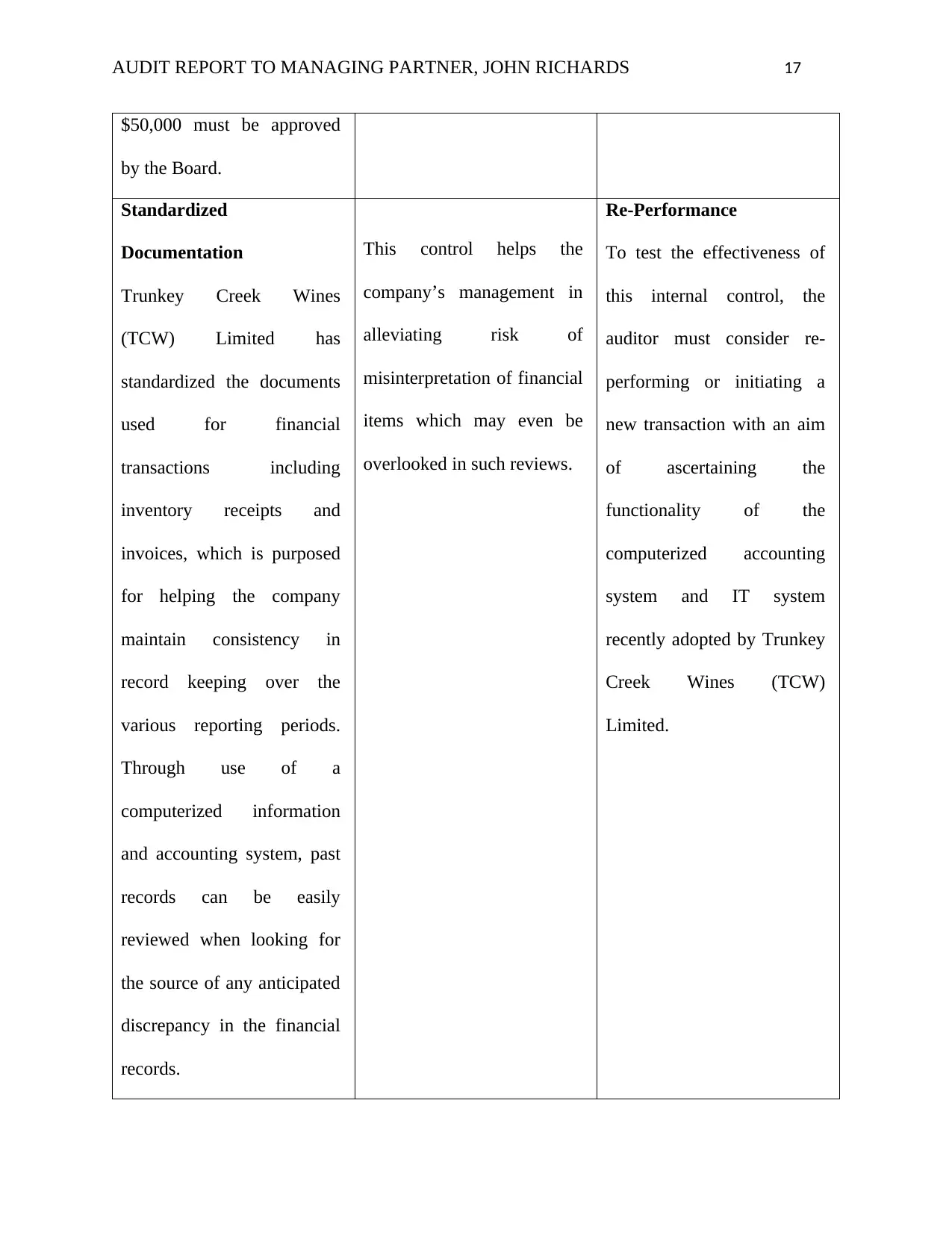
AUDIT REPORT TO MANAGING PARTNER, JOHN RICHARDS 17
$50,000 must be approved
by the Board.
Standardized
Documentation
Trunkey Creek Wines
(TCW) Limited has
standardized the documents
used for financial
transactions including
inventory receipts and
invoices, which is purposed
for helping the company
maintain consistency in
record keeping over the
various reporting periods.
Through use of a
computerized information
and accounting system, past
records can be easily
reviewed when looking for
the source of any anticipated
discrepancy in the financial
records.
This control helps the
company’s management in
alleviating risk of
misinterpretation of financial
items which may even be
overlooked in such reviews.
Re-Performance
To test the effectiveness of
this internal control, the
auditor must consider re-
performing or initiating a
new transaction with an aim
of ascertaining the
functionality of the
computerized accounting
system and IT system
recently adopted by Trunkey
Creek Wines (TCW)
Limited.
$50,000 must be approved
by the Board.
Standardized
Documentation
Trunkey Creek Wines
(TCW) Limited has
standardized the documents
used for financial
transactions including
inventory receipts and
invoices, which is purposed
for helping the company
maintain consistency in
record keeping over the
various reporting periods.
Through use of a
computerized information
and accounting system, past
records can be easily
reviewed when looking for
the source of any anticipated
discrepancy in the financial
records.
This control helps the
company’s management in
alleviating risk of
misinterpretation of financial
items which may even be
overlooked in such reviews.
Re-Performance
To test the effectiveness of
this internal control, the
auditor must consider re-
performing or initiating a
new transaction with an aim
of ascertaining the
functionality of the
computerized accounting
system and IT system
recently adopted by Trunkey
Creek Wines (TCW)
Limited.
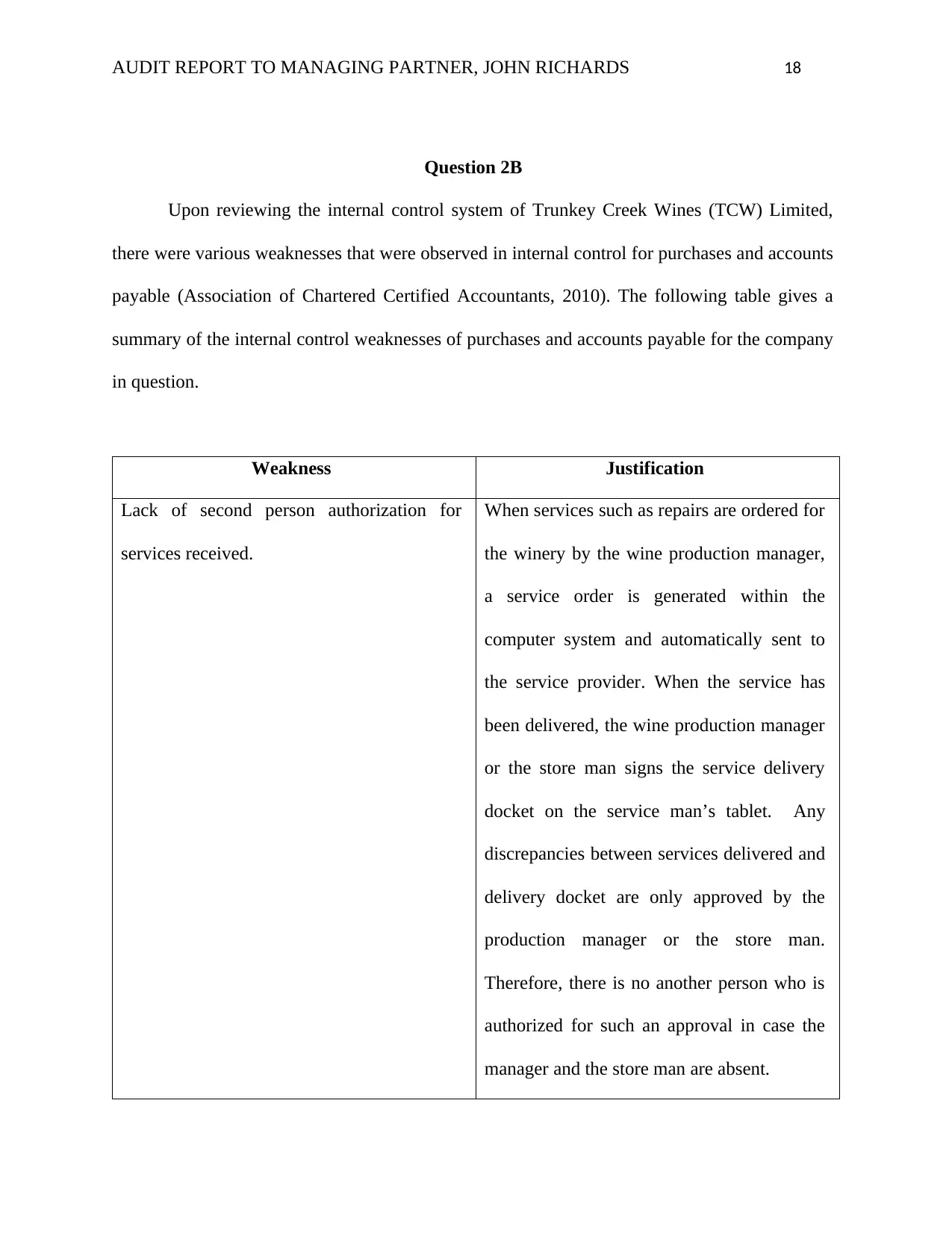
AUDIT REPORT TO MANAGING PARTNER, JOHN RICHARDS 18
Question 2B
Upon reviewing the internal control system of Trunkey Creek Wines (TCW) Limited,
there were various weaknesses that were observed in internal control for purchases and accounts
payable (Association of Chartered Certified Accountants, 2010). The following table gives a
summary of the internal control weaknesses of purchases and accounts payable for the company
in question.
Weakness Justification
Lack of second person authorization for
services received.
When services such as repairs are ordered for
the winery by the wine production manager,
a service order is generated within the
computer system and automatically sent to
the service provider. When the service has
been delivered, the wine production manager
or the store man signs the service delivery
docket on the service man’s tablet. Any
discrepancies between services delivered and
delivery docket are only approved by the
production manager or the store man.
Therefore, there is no another person who is
authorized for such an approval in case the
manager and the store man are absent.
Question 2B
Upon reviewing the internal control system of Trunkey Creek Wines (TCW) Limited,
there were various weaknesses that were observed in internal control for purchases and accounts
payable (Association of Chartered Certified Accountants, 2010). The following table gives a
summary of the internal control weaknesses of purchases and accounts payable for the company
in question.
Weakness Justification
Lack of second person authorization for
services received.
When services such as repairs are ordered for
the winery by the wine production manager,
a service order is generated within the
computer system and automatically sent to
the service provider. When the service has
been delivered, the wine production manager
or the store man signs the service delivery
docket on the service man’s tablet. Any
discrepancies between services delivered and
delivery docket are only approved by the
production manager or the store man.
Therefore, there is no another person who is
authorized for such an approval in case the
manager and the store man are absent.
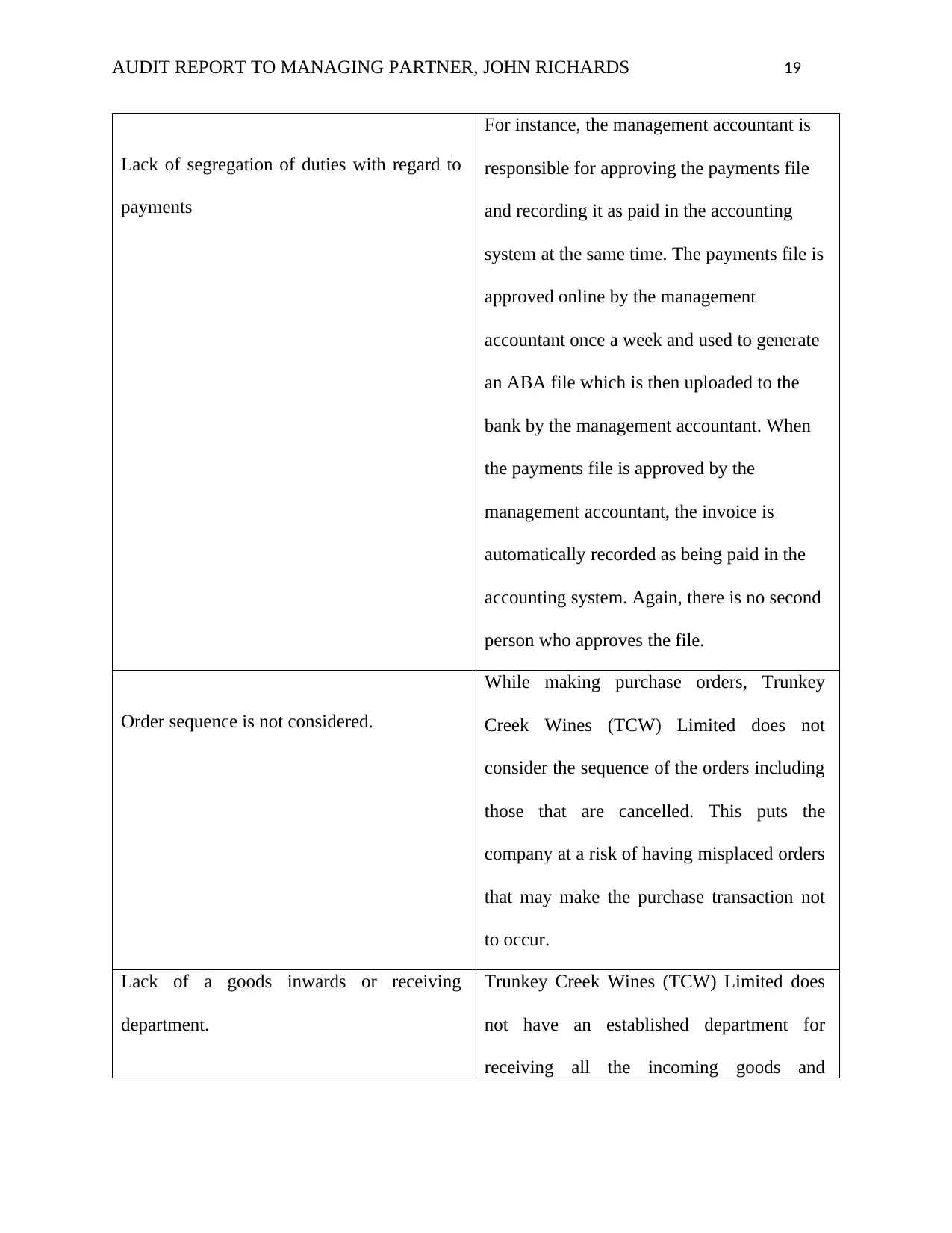
AUDIT REPORT TO MANAGING PARTNER, JOHN RICHARDS 19
Lack of segregation of duties with regard to
payments
For instance, the management accountant is
responsible for approving the payments file
and recording it as paid in the accounting
system at the same time. The payments file is
approved online by the management
accountant once a week and used to generate
an ABA file which is then uploaded to the
bank by the management accountant. When
the payments file is approved by the
management accountant, the invoice is
automatically recorded as being paid in the
accounting system. Again, there is no second
person who approves the file.
Order sequence is not considered.
While making purchase orders, Trunkey
Creek Wines (TCW) Limited does not
consider the sequence of the orders including
those that are cancelled. This puts the
company at a risk of having misplaced orders
that may make the purchase transaction not
to occur.
Lack of a goods inwards or receiving
department.
Trunkey Creek Wines (TCW) Limited does
not have an established department for
receiving all the incoming goods and
Lack of segregation of duties with regard to
payments
For instance, the management accountant is
responsible for approving the payments file
and recording it as paid in the accounting
system at the same time. The payments file is
approved online by the management
accountant once a week and used to generate
an ABA file which is then uploaded to the
bank by the management accountant. When
the payments file is approved by the
management accountant, the invoice is
automatically recorded as being paid in the
accounting system. Again, there is no second
person who approves the file.
Order sequence is not considered.
While making purchase orders, Trunkey
Creek Wines (TCW) Limited does not
consider the sequence of the orders including
those that are cancelled. This puts the
company at a risk of having misplaced orders
that may make the purchase transaction not
to occur.
Lack of a goods inwards or receiving
department.
Trunkey Creek Wines (TCW) Limited does
not have an established department for
receiving all the incoming goods and
Secure Best Marks with AI Grader
Need help grading? Try our AI Grader for instant feedback on your assignments.
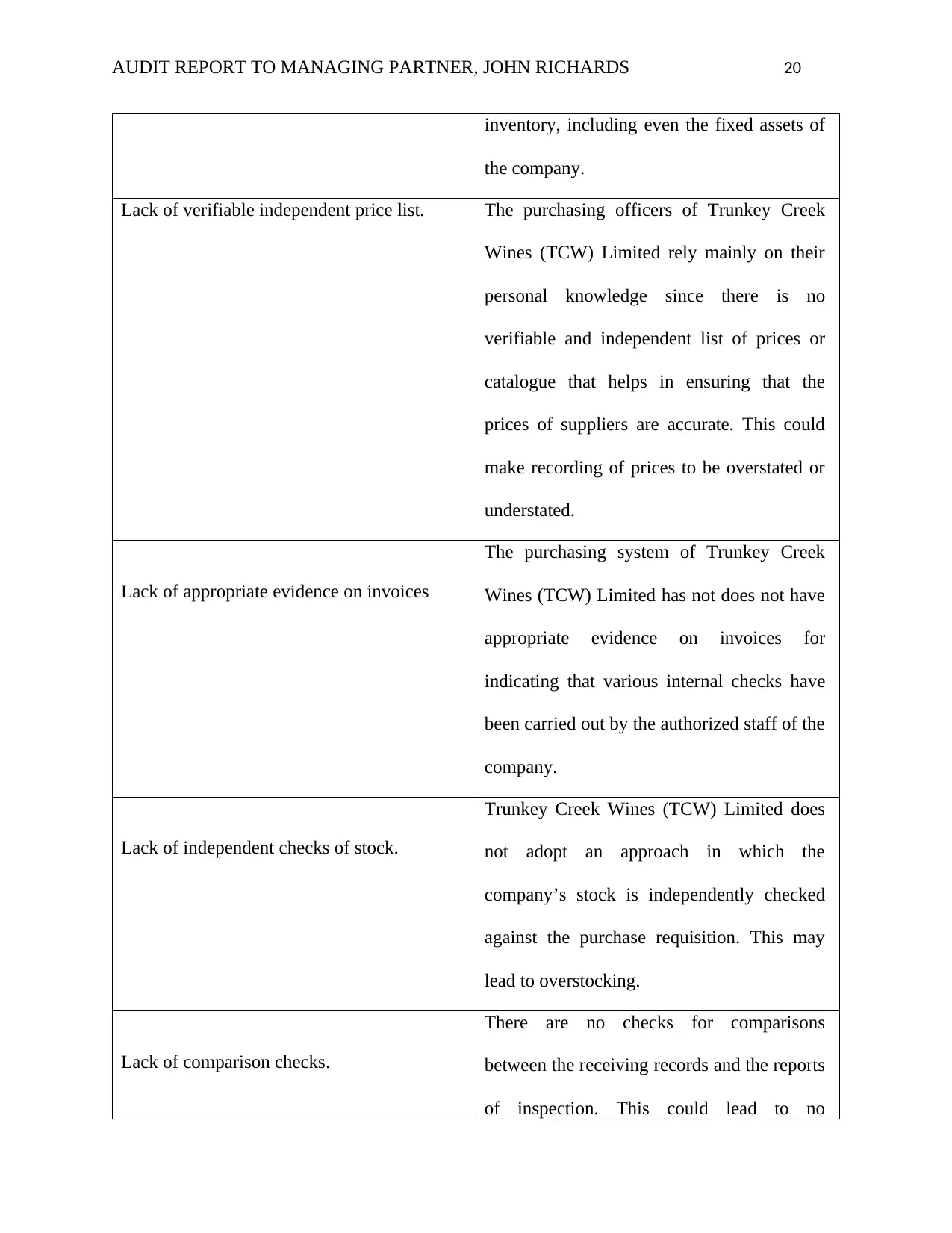
AUDIT REPORT TO MANAGING PARTNER, JOHN RICHARDS 20
inventory, including even the fixed assets of
the company.
Lack of verifiable independent price list. The purchasing officers of Trunkey Creek
Wines (TCW) Limited rely mainly on their
personal knowledge since there is no
verifiable and independent list of prices or
catalogue that helps in ensuring that the
prices of suppliers are accurate. This could
make recording of prices to be overstated or
understated.
Lack of appropriate evidence on invoices
The purchasing system of Trunkey Creek
Wines (TCW) Limited has not does not have
appropriate evidence on invoices for
indicating that various internal checks have
been carried out by the authorized staff of the
company.
Lack of independent checks of stock.
Trunkey Creek Wines (TCW) Limited does
not adopt an approach in which the
company’s stock is independently checked
against the purchase requisition. This may
lead to overstocking.
Lack of comparison checks.
There are no checks for comparisons
between the receiving records and the reports
of inspection. This could lead to no
inventory, including even the fixed assets of
the company.
Lack of verifiable independent price list. The purchasing officers of Trunkey Creek
Wines (TCW) Limited rely mainly on their
personal knowledge since there is no
verifiable and independent list of prices or
catalogue that helps in ensuring that the
prices of suppliers are accurate. This could
make recording of prices to be overstated or
understated.
Lack of appropriate evidence on invoices
The purchasing system of Trunkey Creek
Wines (TCW) Limited has not does not have
appropriate evidence on invoices for
indicating that various internal checks have
been carried out by the authorized staff of the
company.
Lack of independent checks of stock.
Trunkey Creek Wines (TCW) Limited does
not adopt an approach in which the
company’s stock is independently checked
against the purchase requisition. This may
lead to overstocking.
Lack of comparison checks.
There are no checks for comparisons
between the receiving records and the reports
of inspection. This could lead to no
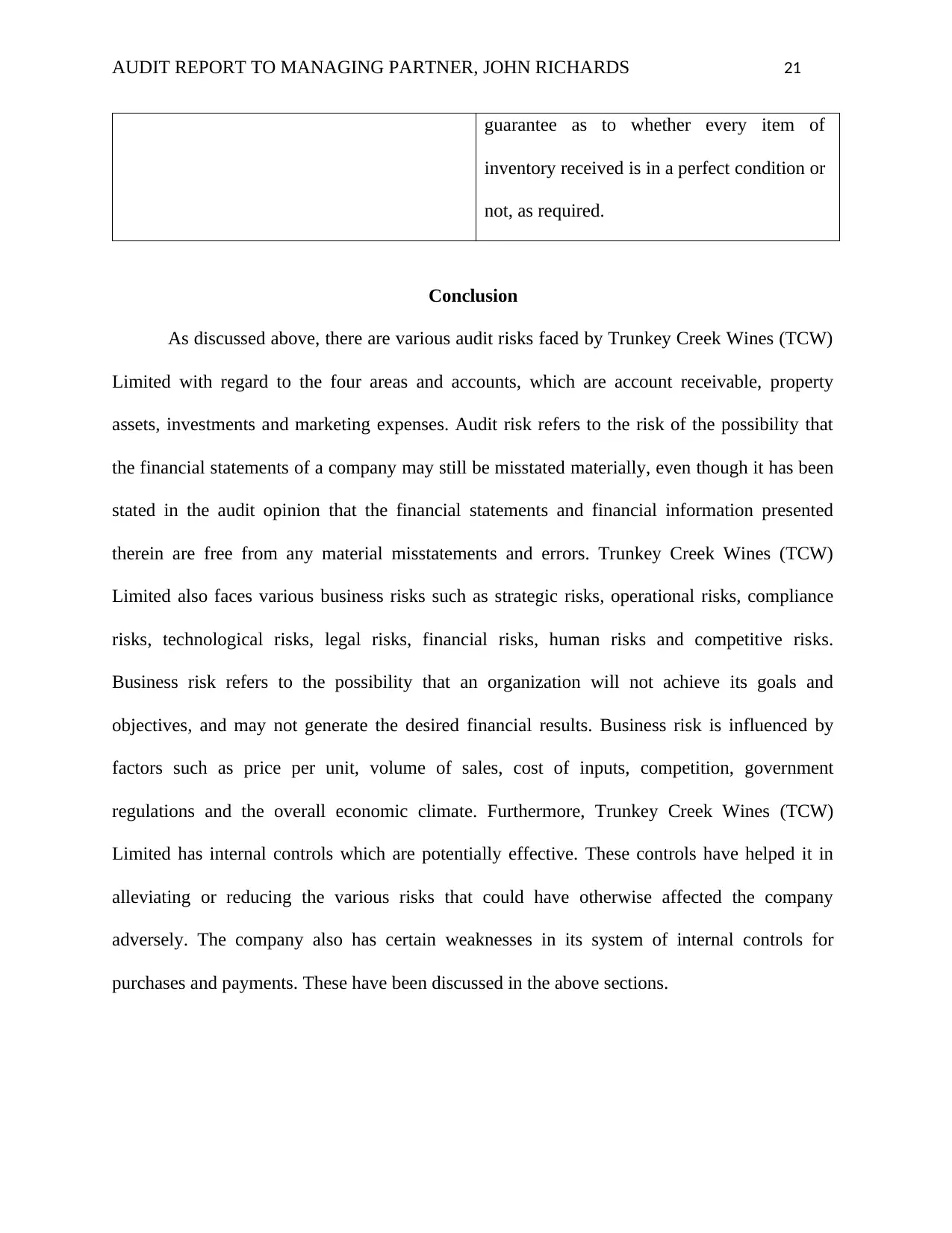
AUDIT REPORT TO MANAGING PARTNER, JOHN RICHARDS 21
guarantee as to whether every item of
inventory received is in a perfect condition or
not, as required.
Conclusion
As discussed above, there are various audit risks faced by Trunkey Creek Wines (TCW)
Limited with regard to the four areas and accounts, which are account receivable, property
assets, investments and marketing expenses. Audit risk refers to the risk of the possibility that
the financial statements of a company may still be misstated materially, even though it has been
stated in the audit opinion that the financial statements and financial information presented
therein are free from any material misstatements and errors. Trunkey Creek Wines (TCW)
Limited also faces various business risks such as strategic risks, operational risks, compliance
risks, technological risks, legal risks, financial risks, human risks and competitive risks.
Business risk refers to the possibility that an organization will not achieve its goals and
objectives, and may not generate the desired financial results. Business risk is influenced by
factors such as price per unit, volume of sales, cost of inputs, competition, government
regulations and the overall economic climate. Furthermore, Trunkey Creek Wines (TCW)
Limited has internal controls which are potentially effective. These controls have helped it in
alleviating or reducing the various risks that could have otherwise affected the company
adversely. The company also has certain weaknesses in its system of internal controls for
purchases and payments. These have been discussed in the above sections.
guarantee as to whether every item of
inventory received is in a perfect condition or
not, as required.
Conclusion
As discussed above, there are various audit risks faced by Trunkey Creek Wines (TCW)
Limited with regard to the four areas and accounts, which are account receivable, property
assets, investments and marketing expenses. Audit risk refers to the risk of the possibility that
the financial statements of a company may still be misstated materially, even though it has been
stated in the audit opinion that the financial statements and financial information presented
therein are free from any material misstatements and errors. Trunkey Creek Wines (TCW)
Limited also faces various business risks such as strategic risks, operational risks, compliance
risks, technological risks, legal risks, financial risks, human risks and competitive risks.
Business risk refers to the possibility that an organization will not achieve its goals and
objectives, and may not generate the desired financial results. Business risk is influenced by
factors such as price per unit, volume of sales, cost of inputs, competition, government
regulations and the overall economic climate. Furthermore, Trunkey Creek Wines (TCW)
Limited has internal controls which are potentially effective. These controls have helped it in
alleviating or reducing the various risks that could have otherwise affected the company
adversely. The company also has certain weaknesses in its system of internal controls for
purchases and payments. These have been discussed in the above sections.
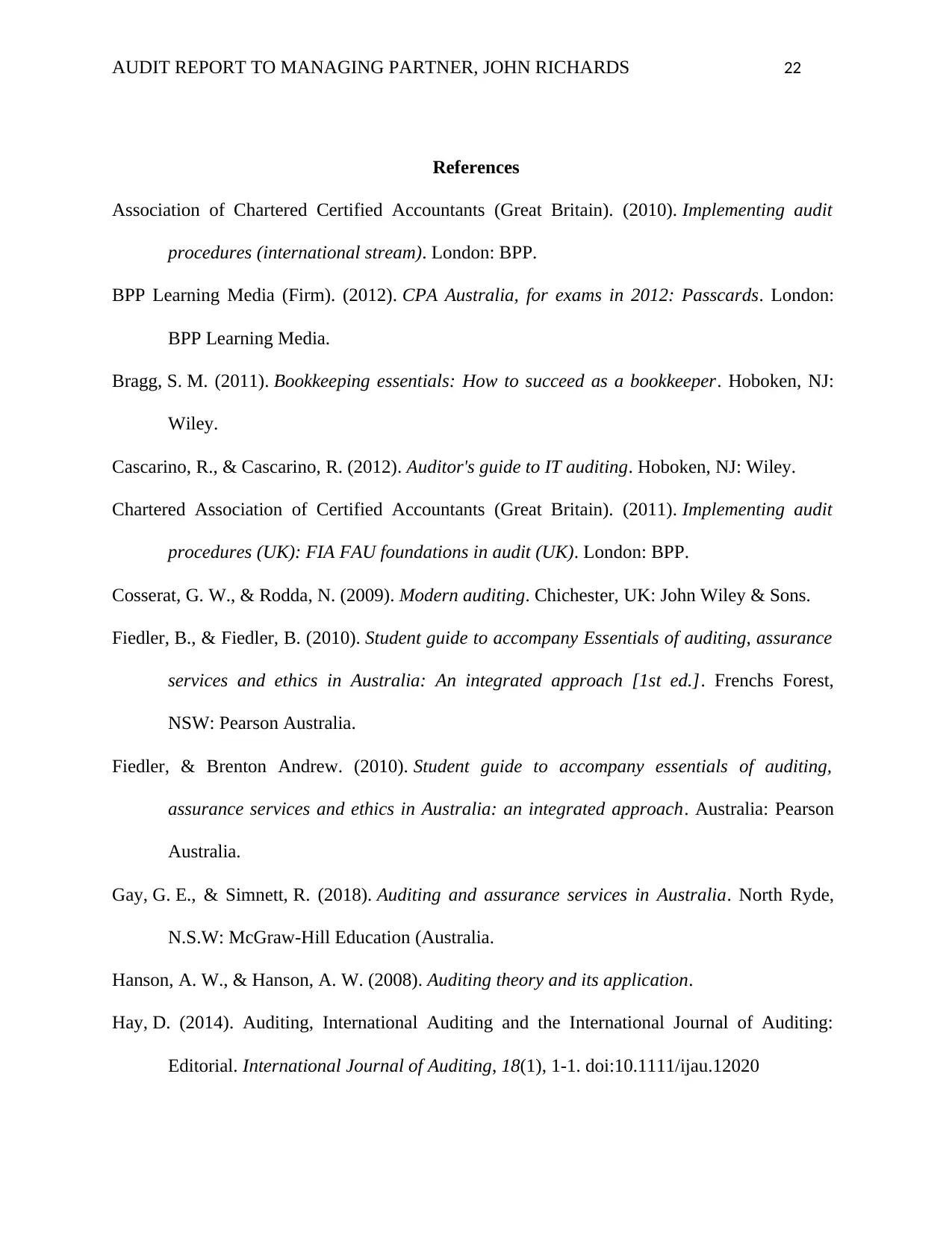
AUDIT REPORT TO MANAGING PARTNER, JOHN RICHARDS 22
References
Association of Chartered Certified Accountants (Great Britain). (2010). Implementing audit
procedures (international stream). London: BPP.
BPP Learning Media (Firm). (2012). CPA Australia, for exams in 2012: Passcards. London:
BPP Learning Media.
Bragg, S. M. (2011). Bookkeeping essentials: How to succeed as a bookkeeper. Hoboken, NJ:
Wiley.
Cascarino, R., & Cascarino, R. (2012). Auditor's guide to IT auditing. Hoboken, NJ: Wiley.
Chartered Association of Certified Accountants (Great Britain). (2011). Implementing audit
procedures (UK): FIA FAU foundations in audit (UK). London: BPP.
Cosserat, G. W., & Rodda, N. (2009). Modern auditing. Chichester, UK: John Wiley & Sons.
Fiedler, B., & Fiedler, B. (2010). Student guide to accompany Essentials of auditing, assurance
services and ethics in Australia: An integrated approach [1st ed.]. Frenchs Forest,
NSW: Pearson Australia.
Fiedler, & Brenton Andrew. (2010). Student guide to accompany essentials of auditing,
assurance services and ethics in Australia: an integrated approach. Australia: Pearson
Australia.
Gay, G. E., & Simnett, R. (2018). Auditing and assurance services in Australia. North Ryde,
N.S.W: McGraw-Hill Education (Australia.
Hanson, A. W., & Hanson, A. W. (2008). Auditing theory and its application.
Hay, D. (2014). Auditing, International Auditing and the International Journal of Auditing:
Editorial. International Journal of Auditing, 18(1), 1-1. doi:10.1111/ijau.12020
References
Association of Chartered Certified Accountants (Great Britain). (2010). Implementing audit
procedures (international stream). London: BPP.
BPP Learning Media (Firm). (2012). CPA Australia, for exams in 2012: Passcards. London:
BPP Learning Media.
Bragg, S. M. (2011). Bookkeeping essentials: How to succeed as a bookkeeper. Hoboken, NJ:
Wiley.
Cascarino, R., & Cascarino, R. (2012). Auditor's guide to IT auditing. Hoboken, NJ: Wiley.
Chartered Association of Certified Accountants (Great Britain). (2011). Implementing audit
procedures (UK): FIA FAU foundations in audit (UK). London: BPP.
Cosserat, G. W., & Rodda, N. (2009). Modern auditing. Chichester, UK: John Wiley & Sons.
Fiedler, B., & Fiedler, B. (2010). Student guide to accompany Essentials of auditing, assurance
services and ethics in Australia: An integrated approach [1st ed.]. Frenchs Forest,
NSW: Pearson Australia.
Fiedler, & Brenton Andrew. (2010). Student guide to accompany essentials of auditing,
assurance services and ethics in Australia: an integrated approach. Australia: Pearson
Australia.
Gay, G. E., & Simnett, R. (2018). Auditing and assurance services in Australia. North Ryde,
N.S.W: McGraw-Hill Education (Australia.
Hanson, A. W., & Hanson, A. W. (2008). Auditing theory and its application.
Hay, D. (2014). Auditing, International Auditing and the International Journal of Auditing:
Editorial. International Journal of Auditing, 18(1), 1-1. doi:10.1111/ijau.12020
Paraphrase This Document
Need a fresh take? Get an instant paraphrase of this document with our AI Paraphraser
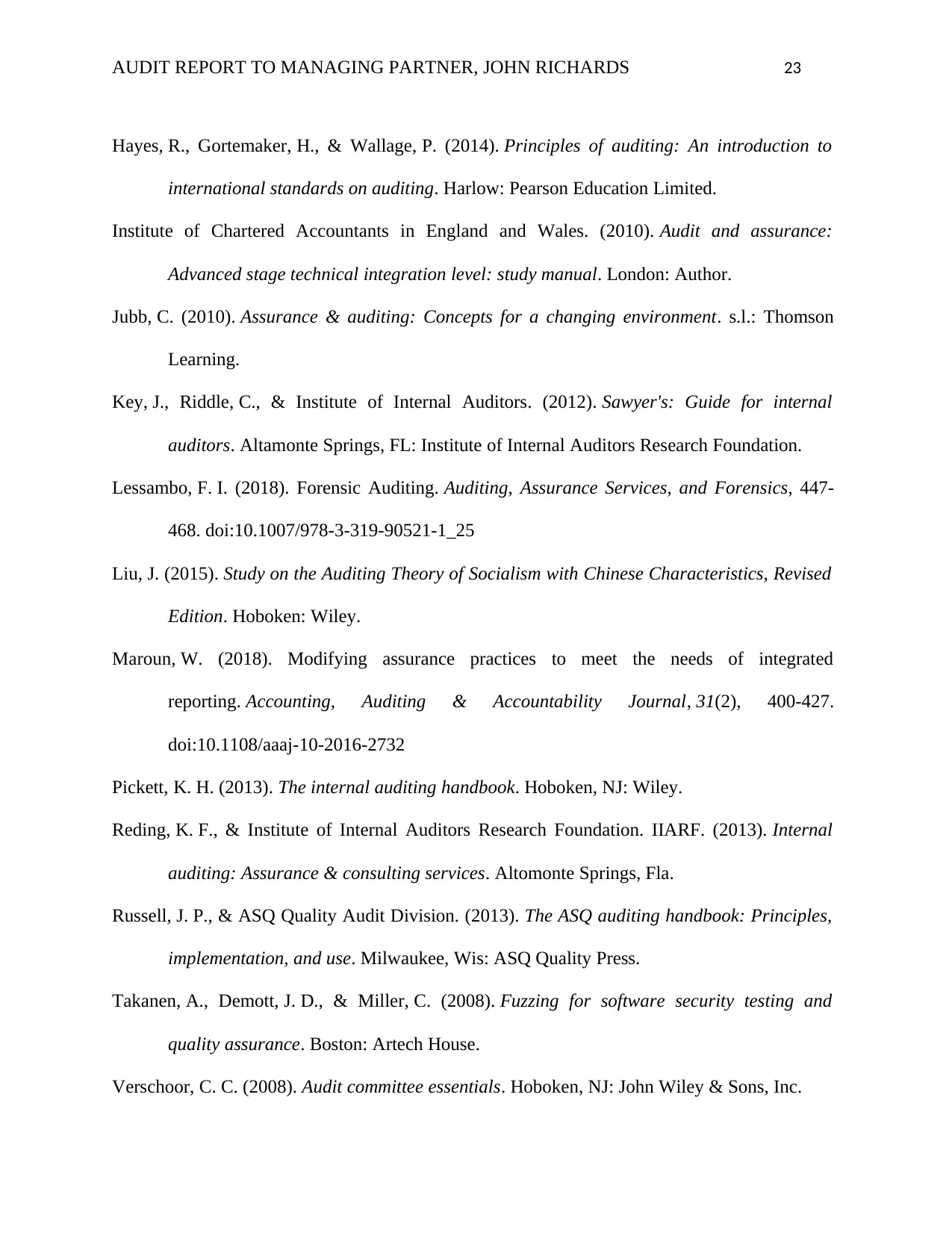
AUDIT REPORT TO MANAGING PARTNER, JOHN RICHARDS 23
Hayes, R., Gortemaker, H., & Wallage, P. (2014). Principles of auditing: An introduction to
international standards on auditing. Harlow: Pearson Education Limited.
Institute of Chartered Accountants in England and Wales. (2010). Audit and assurance:
Advanced stage technical integration level: study manual. London: Author.
Jubb, C. (2010). Assurance & auditing: Concepts for a changing environment. s.l.: Thomson
Learning.
Key, J., Riddle, C., & Institute of Internal Auditors. (2012). Sawyer's: Guide for internal
auditors. Altamonte Springs, FL: Institute of Internal Auditors Research Foundation.
Lessambo, F. I. (2018). Forensic Auditing. Auditing, Assurance Services, and Forensics, 447-
468. doi:10.1007/978-3-319-90521-1_25
Liu, J. (2015). Study on the Auditing Theory of Socialism with Chinese Characteristics, Revised
Edition. Hoboken: Wiley.
Maroun, W. (2018). Modifying assurance practices to meet the needs of integrated
reporting. Accounting, Auditing & Accountability Journal, 31(2), 400-427.
doi:10.1108/aaaj-10-2016-2732
Pickett, K. H. (2013). The internal auditing handbook. Hoboken, NJ: Wiley.
Reding, K. F., & Institute of Internal Auditors Research Foundation. IIARF. (2013). Internal
auditing: Assurance & consulting services. Altomonte Springs, Fla.
Russell, J. P., & ASQ Quality Audit Division. (2013). The ASQ auditing handbook: Principles,
implementation, and use. Milwaukee, Wis: ASQ Quality Press.
Takanen, A., Demott, J. D., & Miller, C. (2008). Fuzzing for software security testing and
quality assurance. Boston: Artech House.
Verschoor, C. C. (2008). Audit committee essentials. Hoboken, NJ: John Wiley & Sons, Inc.
Hayes, R., Gortemaker, H., & Wallage, P. (2014). Principles of auditing: An introduction to
international standards on auditing. Harlow: Pearson Education Limited.
Institute of Chartered Accountants in England and Wales. (2010). Audit and assurance:
Advanced stage technical integration level: study manual. London: Author.
Jubb, C. (2010). Assurance & auditing: Concepts for a changing environment. s.l.: Thomson
Learning.
Key, J., Riddle, C., & Institute of Internal Auditors. (2012). Sawyer's: Guide for internal
auditors. Altamonte Springs, FL: Institute of Internal Auditors Research Foundation.
Lessambo, F. I. (2018). Forensic Auditing. Auditing, Assurance Services, and Forensics, 447-
468. doi:10.1007/978-3-319-90521-1_25
Liu, J. (2015). Study on the Auditing Theory of Socialism with Chinese Characteristics, Revised
Edition. Hoboken: Wiley.
Maroun, W. (2018). Modifying assurance practices to meet the needs of integrated
reporting. Accounting, Auditing & Accountability Journal, 31(2), 400-427.
doi:10.1108/aaaj-10-2016-2732
Pickett, K. H. (2013). The internal auditing handbook. Hoboken, NJ: Wiley.
Reding, K. F., & Institute of Internal Auditors Research Foundation. IIARF. (2013). Internal
auditing: Assurance & consulting services. Altomonte Springs, Fla.
Russell, J. P., & ASQ Quality Audit Division. (2013). The ASQ auditing handbook: Principles,
implementation, and use. Milwaukee, Wis: ASQ Quality Press.
Takanen, A., Demott, J. D., & Miller, C. (2008). Fuzzing for software security testing and
quality assurance. Boston: Artech House.
Verschoor, C. C. (2008). Audit committee essentials. Hoboken, NJ: John Wiley & Sons, Inc.
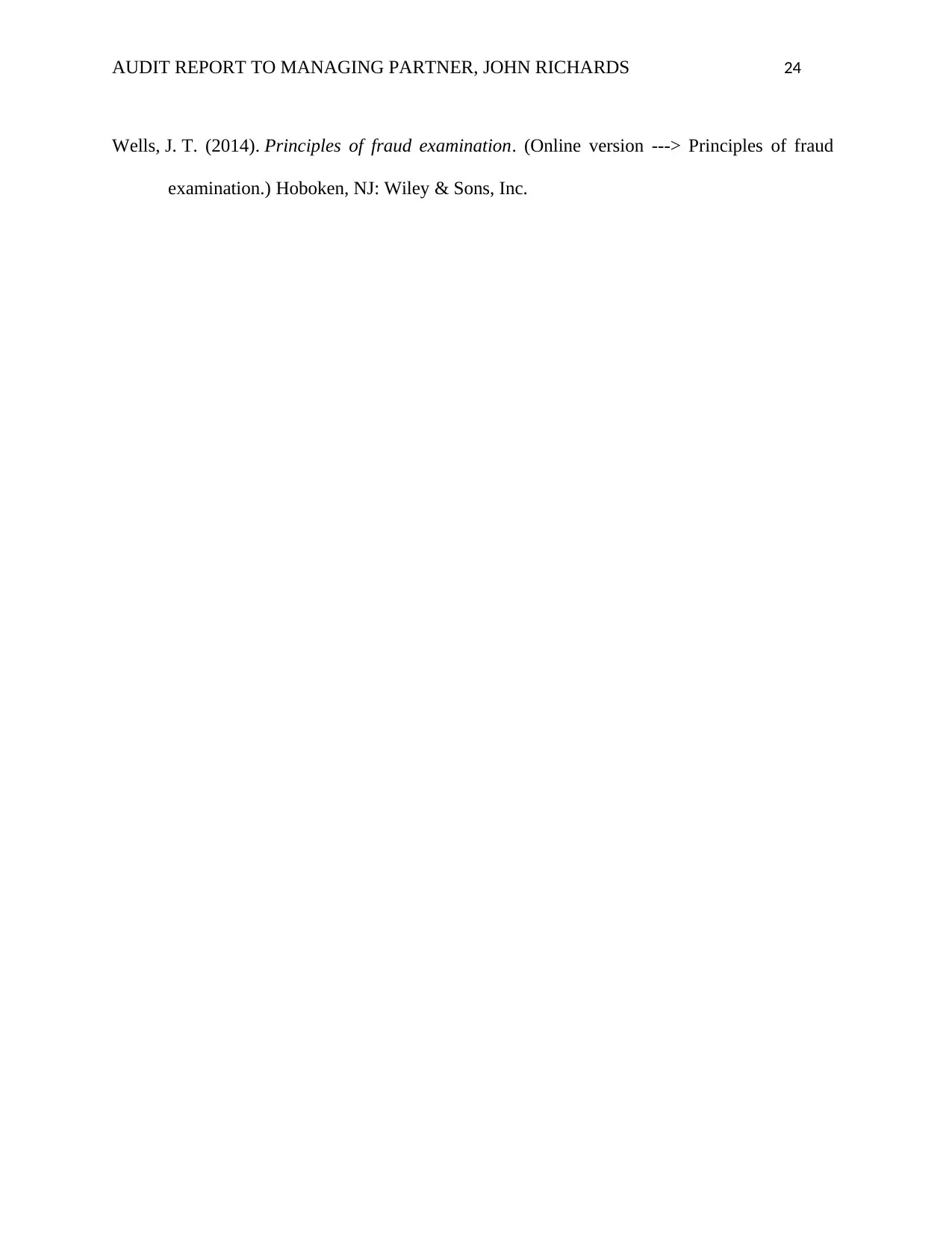
AUDIT REPORT TO MANAGING PARTNER, JOHN RICHARDS 24
Wells, J. T. (2014). Principles of fraud examination. (Online version ---> Principles of fraud
examination.) Hoboken, NJ: Wiley & Sons, Inc.
Wells, J. T. (2014). Principles of fraud examination. (Online version ---> Principles of fraud
examination.) Hoboken, NJ: Wiley & Sons, Inc.
1 out of 24
Related Documents
Your All-in-One AI-Powered Toolkit for Academic Success.
+13062052269
info@desklib.com
Available 24*7 on WhatsApp / Email
![[object Object]](/_next/static/media/star-bottom.7253800d.svg)
Unlock your academic potential
© 2024 | Zucol Services PVT LTD | All rights reserved.




